Louisiana Hurricane History
David Roth
National Weather Service
Camp Springs, MD

2
Table of Contents
Climatology of Tropical Cyclones in Louisiana
3
List of Louisiana Hurricanes
8
Spanish Conquistadors and the Storm of 1527
11
Hurricanes of the Eighteenth Century
11
Hurricanes of the Early Nineteenth Century
14
Hurricanes of the Late Nineteenth Century
17
Deadliest Hurricane in Louisiana History - Chenier Caminanda (1893)
25
Hurricanes of the Early Twentieth Century
28
Hurricanes of the Late Twentieth Century
37
Hurricanes of the Early Twenty-First Century
51
Acknowledgments
57
Bibliography
58

Climatology of Tropical Cyclones in Louisiana
3
“We live in the shadow of a danger over which we have no control: the Gulf, like
a provoked and angry giant, can awake from its seeming lethargy, overstep its
conventional boundaries, invade our land and spread chaos and disaster” - Part of
“Prayer for Hurricane Season” read as Grand Chenier every weekend of summer
(Gomez).
Some of the deadliest tropical storms and hurricanes to ever hit the United States have
struck the Louisiana shoreline. Memorable storms include Andrew in 1992, Camille in 1969,
Betsy in 1965, Audrey in 1957, the August Hurricane of 1940, the September Hurricane of 1915,
the Cheniere Caminanda hurricane of October 1893, the Isle Dernieres storm of 1856, and the
Racer’s Storm of 1837. These storms claimed as many as 3000 lives from the area....with
Audrey having the highest death toll in modern times in the United States from any tropical
cyclone, with 526 lives lost in Cameron and nine in Texas.
Louisiana has few barrier islands; therefore, the problem of overpopulation along the
coast slowing down evacuation times, such as Florida, does not exist. New Orleans has high
evacuation times due to a relative lack of major highways out of the city and dense population
....Interstate highway 10 is virtually the only route of escape.
A lack of coastal irregularities and a generally smooth bottom to the Gulf of Mexico make
Cameron Parish ideal to maximum wave damage along its shores (Morgan). The land in the
lower sections of the state is slowly sinking and quickly eroding away. Nowhere is the sinking
more evident than in New Orleans. Back in 1718, the levee system was only 3 feet high; today,
the levees are 17 feet high. Some of the increases, though, are due to experience over a lengthy
period of time through very strong hurricanes, which were seldom experienced in the early
1700's due to low population density.
Pressure.
The stronger a hurricane gets, the lower its central pressure gets. It is a direct
relationship. Below is a table showing the lowest ten pressures ever recorded across Louisiana
since the Nineteenth Century.
Pressure
Date Location
27.17" 8/29/2005 Buras
27.90" 8/17/1969 Garden Island
28.00" 9/09/1965 Houma & Grand Isle
28.01" 9/29/1915 New Orleans Harbor
28.15" 9/01/2008 Caillou Lake
28.20" 8/11/1856 Isle Dernieres

4
28.31" 8/26/1926 Houma
28.36" 8/06/1918 Sulphur
28.40" 10/3/1964 Franklin
28.56" 8/18/1969 Slidell
Winds. Major hurricanes have led to massive devastation through the years. Extreme structural
damage is noted with storms of category three intensity of higher (winds of 111 mph and
above). Below is a chart showing the highest wind gusts measured across the Bayou State over
the years.
Highest Gusts Location Date
175 mph Bayou Teche 8/26/1992
160 mph Lower Plaquemines 8/17/1969
160 mph Grand Isle 9/09/1965
150 mph Oil Rig offshore SW Louisiana 6/27/1957
135 mph Franklin 10/3/1964
130 mph New Canal Lighthouse 9/29/1915
125 mph Sulphur 8/06/1918
125 mph New Orleans 9/20/1947
125 mph Slidell 8/18/1969
120 mph Thibodaux & Napoleonville 8/26/1926
120 mph Abbeville 9/08/1974
Storm Surge. Storm surge flooding across Southeast Louisiana is greater than surrounding
areas due to its orientation of being a “corner” along the coast. This means that the approximate
angle made by the Mississippi Delta with the Gulf coast to the east is ninety degrees, which
would amplify the piling up of water. In this case, Lakes Pontchartrain and Borgne are the
targets. Another “corner” along the U.S. coast is New York City.
Rainfall.
Heavy rains and flooding are the primary problem associated with tropical cyclones
across the Pelican State. The worst aspect of tropical cyclones is that the weaker a system is, the
more effective a rainmaker it tends to be. Also, tropical systems with large circulation patterns
are most efficient at producing excessive rains that more intense hurricanes, mainly because
intense hurricanes have decreased circulation patterns as they become more efficient at
harnessing the warm and moisture for the ocean.
Recent examples of flooding across the state from tropical cyclones include Frances of 1998,
Allison in 1989, Bonnie (NW Louisiana) in 1986, Juan in 1985, and Claudette in 1979.
However, if it were not for the intermittent invasions from tropical cyclones, rainfall during the
months of August, September, and October would average about 25% less that it currently does.

5
In most cases, the heaviest rain around a tropical storm or hurricane is dumped to the right of its
track. Naturally, the slower a tropical system moves, the greater the rainfall a location can
expect. When a cyclone interacts with old frontal boundary, a secondary rainfall maximum will
occur at and to the north of the boundary in question. Luckily, Louisiana has very little
topography, which makes rainfall amounts above 30" and landslides exceedingly rare events.
When a tropical cyclone transitions to a non-tropical low, dry air will wrap around the southern
and eventually eastern side of the storm. Maxima in rainfall will occur just west and distant to
the east of the track; the least amount of rain will fall in the system's "dry slot", a relatively
cloud-free area south/southwest of a non-tropical low. Severe weather such as downbursts,
tornadoes, and hail are more commonly seen as dry air intrudes into the cyclone's circulation.
In any event, rain will fall more distantly to the east of the center than it will to the west.
Upward vertical motions/warm air advection will occur to the east of the center, while
subsidence/cool air advection will occur to the west. This leads to a sharp contrast in weather to
the west of the point of landfall, between continuous heavy rain with high temperatures hovering
near 80, and sunny skies seen just to their west with high temperatures at or above 100 degrees.
Below is a table showing the ten highest rainfall amounts ever reported in Louisiana with
tropical cyclones.
Amount Location Dates
33.71" Crowley 8/06-10/1940
31.66" Abbeville 8/06-10/1940
29.92” Thibodaux 6/5-11/2001
29.65" Lafayette 8/06-10/1940
25.67 Winnfield 6/23-7/7/1989
22.39" Terrytown 9/10-14/1998
21.30" Logansport 7/22-26/1933
21.00" Larto Lake 8/29-9/5/2008
19.26" Morgan City 9/15-19/1943
18.30" Vinton 9/15-20/1963

6
Fatalities. The further you go back in time, the more people died from hurricanes. In the
Twentieth century, there was a steep dropoff in the number of deaths from cyclones due to
timely warnings by the National Weather Service, and also by information campaigns by the
public and private sector about the dangers of these storms. Katrina (2005) shows that there is
still much to do in regards to education and evacuation efforts for New Orleans. Below shows
the ten most deadly storms ever to effect Louisiana.
Fatalities Dates
2,000 10/1-2/1893
1,577 8/29/2005
526 6/27/1957
353 9/20/1909
275 9/29/1915
218+ 8/10-12/1856
110 10/12/1886
81 10/3/1964
51 9/19-20/1947
47 8/11/1860
Movement. During most months of the hurricane season, tropical cyclones move northwest into
the Pelican State. This is mainly due to the wind flow around the Azores/ Bermuda high
pressure system, which is strongest in July. In June and October, storms are more likely to move
in from the south and southwest. Cold fronts invading the state from the north and west would
cause winds across the Bayou state to become south and southwesterly, quickly picking up any
low pressure system lurking in the Gulf at the time.
Storms are most likely to stall across southwest Louisiana than any other portion of the state. A
climatological "col area" referring to an area between distant low/high pressure cells where
winds are nearly calm, exists across southwest Louisiana and southeast Texas during the
summer. The Bermuda high (outside July) is normally too far east to exert much of a
north/northwesterly motion on a storm while the Mexican Plateau low/trough is normally too far
south to steer a system to the west. Also, this region can lie between segments of the subtropical
ridge centered over the Southwest United States and near Bermuda, leaving the flow pattern aloft
weak. This can cause storms to stall for days across that region; Juan (1985), Claudette (1979),
and Allison (1989) are the most recent storms to stall near the Sabine River.
The list of hurricanes over the next few pages was compiled from numerous sources. The
relative lack of storms before 1829 is due to population mainly being centered around New
Orleans, and a lack of records from the few towns that existed elsewhere. The region now
known as the state of Louisiana wasn’t even settled until 1699. Many ships that may have
encountered storms during the early period of this history took their secrets with them to the
bottom of the Gulf of Mexico.

7
On average, since 1851, 0.7 tropical cyclones of tropical storm strength (2 tropical storms
every 3 years), of which 0.3 are hurricanes (or one hurricane per 3 year period) should be
expected somewhere within the state. A hurricane should make a landfall every 2.8 years. On
the next page is a table of how many tropical storms and hurricanes have made a landfall per
decade in Louisiana since 1851, using statistics from the National Hurricane Center in West
Miami, Florida.
Tropical Cyclone Strikes by The Decade
Decade Hurricanes Tropical Storms Total
1850’s 2 0 2
1860’s 6 2 8
1870's 3 4 7
1880's 6 2 8
1890's 3 5 8
1900's 2 4 6
1910's 2 3 5
1920's 3 2 5
1930's 2 5 7
1940's 3 7 10
1950's 2 7 9
1960's 4 0 4
1970's 4 2 6
1980's 4 2 6
1990's 2 1 3
2000’s 6 6 12
=== === ===
54 52 106
8
Louisiana Hurricanes - 1527 through 2009
Date Name Landfall Wind Category Dead Min Cent Pres
1527, 10/23 - Mouth of MS - - - -
1722, 9/22-4 - New Orleans - - - -
1740, 9/23 - Mouth of MS - - - -
1772, 9/02 - West of Mobile - - - -
1776, ? - New Orleans - - - -
1778, 10/7-10 - Mouth of MS - - - -
1779, 8/18 - New Orleans - - - -
1779, 10/7-10 - New Orleans - - - -
1780, 8/24 - New Orleans - - - -
1781, 8/23 - New Orleans - - - -
1794, 8/31 - New Orleans - - 1+ -
1800, 8/? - New Orleans - - - -
1811, ? - New Orleans - - - -
1812, 8/19-20 - Isle Dernieres - - 45 -
1813, 8/19 - N Gulf Coast - - - -
1819, 7/25-8 - Bay St. Louis - - 43 -
1821, 9/15-7 - Bay St. Louis - - 35 -
1831, 8/16 Great Barbados Isle Dernieres - - 1500 -
1837, 10/5-7 Racer’s Storm Cameron - - 105 -
1846, 4/03 Extratropical? Mouth of MS - - - -
1852, 8/26 Number 1 Pascagoula, MS 115 3 - 961
1855, 9/15-16 Number 5 Mouth of MS 125 3 - -
1856, 8/10-2 Isle Dernieres Isle Dernieres 150 4 200+ 934
1860, 8/11 Number 1 SE Louisiana 125 3 47 -
1860, 9/14-5 Number 4 Mouth of MS 105 2 - -
1860, 10/2-3 Number 6 Atchafalaya 105 2 13 -
1865, 9/12-3 Number 4 Johnson’s Bayou 105 2 23 -
1866, 7/12-13 Number 1 Louisiana Coast 105 2 - -
1867, 10/3-4 Number 7 Venice 105 2 - -
1871, 10/1-4 Number 7 Galveston, TX 80 1 4 -
1879, 8/22-3 Number 3 High Island 105 2 2 964
1879, 9/01 Number 4 Morgan City 120 3 1 -
1882, 9/14 Number 3 Sabine Pass 105 2 - -
1886, 6/13-4 Number 1 Sabine Pass 100 2 - -
1886, 10/12 Number 10 Sabine Pass 120 3 110 -
1887, 10/16-9 Number 13 SE Louisiana 85 1 - -
1888, 8/18-20 Number 3 SE Louisiana 110 2 - -
9
Date Name Landfall Winds Category Dead Min Cent Pres
1893, 9/6-8 Number 8 Morgan City 100 2 - -
1893, 10/1-2 Number 10 Mouth of MS 130 3 2000 948
1897, 9/12 Number 2 Beaumont 85 1 - -
1900, 9/7-8 Galveston HU Galveston, TX 145 4 0 936
1901, 8/14-5 Number 4 Grand Isle 90 2 10 973
1906, 9/26 Number 6 Pascagoula 110 2 - 958
1909, 7/21 Number 4 Freeport, TX 115 3 2 959
1909, 9/20 Number 8 Thibodaux 120 3 353 952
1915, 8/15-7 Number 2 Galveston, TX 130 3 - 940
1915, 9/29 Number 6 Lockport 130 3 275 944
1916, 10/18 Number 14 Pensacola 110 2 - 970
1918, 8/06 Number 1 Cameron 120 3 34 955
1920, 9/21-2 Number 2 Isles Dernieres 100 2 - 975
1923, 10/16 Number 7 Point Au Fer 80 1 - 983
1926, 8/25-7 Number 3 Houma 115 3 25 959
1934, 6/16 Number 2 Morgan City 80 1 7 966
1938, 8/14 Number 2 Cameron 75 1 1 1001
1940, 8/6-10 Number 2 Cameron 80 1 6 972
1941, 9/22-24 Number 2 Texas City, TX 120 3 - 958
1942, 8/19-21 Number 1 Galveston, TX 80 1 - 969
1943, 7/26-27 Number 1 Galveston, TX 100 2 - 969
1947, 9/19 Number 4 New Orleans 80 1 51 966
1948, 9/3-4 Number 5 Timbalier Bay 80 1 - 989
1956, 9/24 Flossy Grand Isle 100 2 8 980
1957, 6/27 Audrey Sabine Pass, TX 145 4 526 946
1960, 9/14 Ethel Port Eads 90 1 - 981
1961, 9/11 Carla Port Lavaca 145 4 39 931
1964, 10/3 Hilda Salt Point 115 3 81 959
1965, 9/10 Betsy Grand Isle 125 3 0 941
1969, 8/17-18 Camille Pass Christian 190 5 - 909
1971, 9/16 Edith Pecan Island 100 2 3 977
1974, 9/7-8 Carmen Point Au Fer 120 3 3 937
1977, 9/6 Babe Cailliou Bay 75 1 - 995
1979, 7/11 Bob Terrebonne Bay 75 1 1 986
1985, 8/16 Danny Pecan Island 90 1 0 988
1985, 9/02 Elena Gulfport 115 3 19 959
1985, 10/29-31 Juan Atchafalaya 85 1 - 971
1986, 6/26-7 Bonnie Sabine Pass, TX 85 1 1 992
1988, 9/09 Florence Port Eads 75 1 - 988
1992, 8/26 Andrew Atchafalaya 115 3 2+ 955
1995, 10/04 Opal Pensacola, FL 115 3 0 942
1997, 7/18 Danny Grand Isle 85 1 - 988
10
Date Name Landfall Winds Category Dead Min Cent Pres
1998, 9/27-28 Georges Pascagoula, MS 110 2 2 987
2002, 10/03 Lili Vermilion Bay 75 1 - 969
2005, 8/29 Katrina Mouth of the MS 125 3 1577 923
2005, 9/24 Rita Johnson’s Bayou 115 3 - 935
2007, 9/13 Humberto Vinton 75 1 - 989
2008, 9/01 Gustav Mouth of the MS 100 2 - 961
2008, 9/13 Ike Point Bolivar, TX 75 1 - 951

11
Spanish Conquistadors and the Storm of 1527
Beginning in the year 1519, Spanish conquistadors began
plundering the New World for the sake of their motherland. Names
such as Ponce de Leon, Fernando Cortes, and Coronado began
exploring the area around the Gulf of Mexico and sent a “quinto”,
Spanish word for one-fifth, of their earnings to the king. To the left
is an artist’s rendition of a Spanish galleon, which would normally
to used to send the royal “quinto” back to Spain.
October 23
rd
, 1527: The earliest reference that can be found to a storm in the Gulf of Mexico
occurred on a voyage of Panfilo de Narvaez, whose nemesis was Fernando Cortes. His luck
usually turned out to be bad, and this mission was no exception. He was sent to settle Florida,
until forced to leave by hostile natives and hunger.
His five boats of less than 250 men hugged the coast and sailed westward. As they were
passing the Mouth of the Mississippi river, a storm caught the barges and “tossed them like
driftwood’ (ChiPMan). This occurred nearly 155 years before La Salle “rediscovered”, and then
lost the location of, the Mouth of the Mississippi river
Hurricanes of the Eighteenth Century
Hurricane dates occurring up to 1752 converted from Julian to Gregorian calendar
September 22-24
th
, 1722: This is the first well-documented hurricane to have hit Louisiana.
It initially moved through the Lesser Antilles on September 11
th
, later making landfall west of
the Mouth of the Mississippi on the 23
rd
, then passing through Central Louisiana. This same
storm most likely recurved northeast into South Carolina, as they reported 3 days of flooding
rains around the 27th.
Winds of hurricane force lasted fifteen hours beginning at 10 PM on the 22
nd
and ending
shortly after noon on the 23
rd
. Storm surges were three feet at Bayou St. John and eight feet in
the Mississippi River. Thirty six huts were destroyed, including the area hospital. These
buildings were hastily constructed in 1717-18 when New Orleans was initially selected to be the
capital of the Louisiana Company after a hurricane devastated Dauphin Island (Sullivan). The
St. Louis church was destroyed. Food crops were lost in Biloxi. This storm was responsible for
the moving of Mobile from 27 miles above the Mouth of the Mobile River to its present day site.
Ships were reported to be sunk in the harbor during this hurricane. Three piroughs loaded
12
with fowl, corn, and other goods were lost up towards the Tensas. The level of the Mississippi
river rose eight feet due to the hurricane. In 1718, a three foot high levee was built to protect
New Orleans from both river and tide overflow. This proved inadequate, as older area
settlements used the devastation of New Orleans in the “Great Hurricane of 1722"
as final proof of that city’s unsuitability as the capital of Louisiana, following a great flood by
only three years.
A “rude little fort” was built in the marshes near the Mouth of the Mississippi River. This
location was discovered by Sieur de la Salle in 1682, lost, then found again before being
inhabited by 1699. It was named La Balize, french for “The Seamark”. In 1721, the first
lighthouse-type structure, rising 62 feet out of the muck and mire, was constructed at that
location. It was one of the first permanent settlements inside the current boundaries of the state
of Louisiana.
September 23
rd
, 1740: Hurricane struck Mouth of the Mississippi River. Destroyed a large
portion of the crops and left many colonists without shelter. The storm, along with others
following it in the 1740's, removed all traces of the original habitation at La Balize. A new
island was formed during the same time frame, called San Carlos. On this island, the Balize
was re-established.
September 4
th
, 1766: A hurricane strikes the Texas coast near Galveston and plays a role
in early Louisiana history. The ship Constante was lost in the storm about 45 miles east of
Calcasieu Pass, and the nearby bayou was named “Bayu del Constante”, or Constance Bayou
(Morgan).
August 31
st
-September 4
th
, 1772 (Bernard Roman’s Hurricane): Hurricane originating
near Jamaica on the 28
th
of August moved north and northwest into the Central Gulf Coast just
west of Mobile. Its effects were far reaching. In Pensacola, it destroyed most of the wharves.
The most devastation occurred in the vicinity of Mobile and the Pasca Oocolo River. Being on
the west side of this storm, the worst innundation occurred at the back of the Chandeleurs, Grand
Gozier, and Breton Isles and cut new channels within the islands. New Orleans itself enjoyed a
sunny day with light winds, though tides along the coast ran above normal.
All shipping at the Mouth of the Mississippi was driven into the marshes. This included the
ship El Principe de Orange, which only had 6 survivors. The Spanish merchant brigantine
Nuestra Señora del Amparo was also wrecked.
1776: A hurricane struck New Orleans. It produced some damage.
October 7-10
th
, 1778: There was a great storm surge that destroyed the establishments of
the Balize, Bayou St. John, and Tigouyou in the Louisiana delta. All structures were wiped out
of existence.
13
August 17-18
th
, 1779: A hurricane made landfall at New Orleans. At the time, Spain had
declared war on Great Britain. Almost all of Bernardo de Galvez’ ships (Governor of New
Orleans) that were to be used to secretly seize the British post at Baton Rouge were grounded or
destroyed, thus ruining his plans for invasion until the 27
th
. The only ship that escaped disaster
was El Volante. Among the ships wrecked was the America La Reseda. Some of the ships were
found in the middle of woods after the storm!
Wind and rain began on the night of the 17
th
. Full violence of the storm was attained by
3 am. All houses, piroughs, barges, and boats were decimated; these included an American
Frigate, the Morris. This vessel was loaded with gunpowder to be used in the American
Revolution against the British in Illinois (Barnes). Fields were leveled and all crops, stock, and
provisions were lost.
During this storm, William Dunbar made observations that uncovered the true nature of
tropical storms and hurricanes; that they had a progressive forward movement and that the
winds revolved around a vortex at the center. He witnessed the 5-6 minute calm at New Orleans,
before the wind reversed and equaled its previous fury (Sullivan). His findings were presented to
the American Philosophical Society in 1801.
October 7-10
th
, 1779: A hurricane is reported to have affected New Orleans. This storm may
be the same as the one listed above in 1778 with the same dates.
August 24
th
, 1780: A hurricane worse than the one in August 1779 swept over the province
of Louisiana striking New Orleans; destroying crops, tearing down buildings and sinking every
vessel and boat afloat on the Mississippi River and on area lakes...the town was leveled. It was
during this storm that Dunbar noted the tornadoes formed around tropical storms and seldom
lasted more than 5 to 10 minutes.
This was of no comfort to the inhabitants of the area, who were distraught after these two
storms, an excessively cold winter and a very rainy summer. This residents wrote the Spanish
sovereign not to abandon the country, regardless of the adverse blows of nature.
August 23
rd
, 1781: A hurricane is reported to have struck New Orleans. It may be a
reference to the previous storm, as no data as been found to support its presence.
August 18
th
, 1793: A strong tropical storm hit New Orleans and destroyed unharvested crops
and devastated rural sections of the province. Four merchantmen were wrecked on the
Mississippi; two were American ships from Philadelphia.
August 31
st
-September 1
st
, 1794: A hurricane that had moved through Cuba on the 27-28
th
struck New Orleans on the 31
st
and produced considerable crop damage. The storm surge
moved inland from Balize westward to the Plaquemines, as much as 10 feet in places, totally
engulfing Fort St. Phillip, drowning their chief engineer. Large hail was also noted in the
14
storm; an unusual event in a tropical cyclone. Nine hours of high wind tormented what is now
Avoyelles Parish on September 1
st
as the storm continued marching northward. Many lives,
cattle, and horses perished in the storm.
August 1800: A hurricane is reported to have struck New Orleans.
Hurricanes of the Early Nineteenth Century
1811: Hurricane struck New Orleans.
August 19-20
th
, 1812: A hurricane struck just west of New Orleans. At 5 PM on the 19
th
,
winds began out of the northeast in New Orleans. Winds increased to a “perfect hurricane” at
11 PM. Winds abated after 2:30 PM on the 20
th
. Nearly all buildings suffered, including those
made of brick. The market house in New Orleans was demolished. The Church of the Covenant
lost its roof. All window panes at City Hall were broken. Fifteen feet of water covered the city.
Extensive damage occurred to trees. The levee was destroyed. The storm surge submerged
areas south of the city. Plaquemines parish was under as much as 15 feet of Gulf waters, where
45 drowned (National Intelligencer). Sugar crops suffered severely.
Damage was significant to their naval base. The U.S. brig Enterprise was shoved ashore,
dragging her anchors. The Viper lost her main mast, and suffered additional damage. Fort St.
Phillip in Plaquemines parish went fully underwater, with most within the fort drowning. Only
six of 60 ships on the Mississippi river were considered worth repairing. At least 10 perished
from the ship Harlequin. The beach of Lake Pontchartrain was strewn with vessel fragments,
their cargo, and victims of the cyclone. Nearly 100 people died during the storm. Losses totaled
$6 million.
Some public panic set in when after the storm rumors spread that the British had taken over
Fort St. Phillip; this storm struck during the thick of the War of 1812 and the fort was controlled
by Americans at the time. In fact, the British fleet approaching the area was scattered widely
across the Gulf during the storm. Fort St. Phillip itself went underwater.
August 19
th
, 1813: A hurricane affected Gulf coast and was considered very destructive.
July 25-28
th
, 1819: Hurricane affected coast from Louisiana to Alabama. It struck Bay St.
Louis. New Orleans was at the fringe of the storm and suffered no severe damage. Ships at
the Balize suffered a strong gale for 24 hours that only grounded three ships. Lakes
Pontchartrain and Borgne rose five to six feet during the storm, with farms along the lakes
flooded by the storm tide. Forty one lives were lost on the U.S. Man of War schooner
Firebrand, a 150 ton gun ship, while it lay off the west end of Cat Island. At
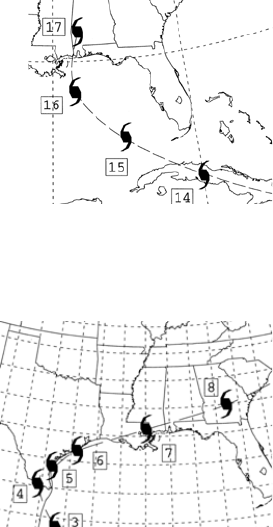
15
least 43 people died in all.
September 15-17
th
, 1821: A second, much larger yet weaker
hurricane struck near Bay St. Louis. The gale continued for over
24 hours at New Orleans, beginning at 6 PM on the 15
th
and
Boufouca. A dozen willow trees were the main casualties there.
The storm was more damaging at Petite Coquille, where four
soldiers drowned when an eight foot storm surge overwashed the
island. The fort there was nearly swept away. The schooner
Brisk was driven onto the Middle Ground in the Mississippi
Delta after becoming dismasted on the 16
th
(it was saved on the 23
rd
). The U.S. Schooner
Enterprize was cast away off Cat Island (Louisiana Courier). At least thirty-five lives were
claimed by the storm.
August 16-17
th
, 1831: The Great Barbados hurricane, very
destructive, hit just west of Last Island, just west of Baton
Rouge. It was considered the strongest hurricane across
southeast Louisiana since 1812 and killed 1500 people along its
path from Barbados to New Orleans. A fishing village on Grand
Isle was destroyed when the tide rose six feet. Barataria saw the
greatest damage as the town and its inhabitants were swept out to
sea (Louisiana Courier). Sugarcane crops suffered severely from
Baton Rouge to Pointe a la Hache. Orchards and gardens in
Plaquemines parish sustained considerable damage. A total of 260 perished statewide, with 150
from Barataria.
August 28-29
th
, 1831: A strong tropical storm struck southwest Louisiana. High tides were
seen west of Lake Borgne...gales raged in New Orleans overnight on the 28-29
th
. Gales were
much more severe near the Sabine River and across central Louisiana near Opelousas and
Attakapes. Cotton was ruined in Baton Rouge and Alexandria due to the heavy rains and winds.
High winds were noted as far northwest as Fort Jessup, southwest of Natchitoches.
October 5-7
th
, 1837 (Racer’s Storm): The Racer’s Storm hit Matamoras, Mexico and caused
great devastation to the Texas coast while recurving northeast and striking Louisiana just east of
Cameron on the 6
th
. It then moved east along the Gulf coast and headed out into the Atlantic by
the 10
th
(track on the right). Storm surges of 8 feet above the normal high tide on Lake
Pontchartrain. The original wooden Bayou St. John lighthouse , the first of its kind built by the
United States outside the original 13 colonies, was swept into obscurity.
New Orleans experienced a gale on the 5
th
and 6
th
, destroying chimneys, awnings, and many
area roofs. The City Exchange on Lewis Street, which was under construction at the time,
suffered much damage. All wharves along the Mississippi coast were washed away with the
tide. The storm caused widespread flooding and considerable damage to shipping; all boats,
including four steamboats, perished in the storm.
16
Lower portions of New Orleans were submerged. Many buildings were damaged or carried
away. Crops were seriously damaged along both sides of the Mississippi, particularly sugar
cane and cotton. Six lives were lost. See Texas Hurricane History for more on the earlier
history of this storm.
September 14
th
, 1839: This storm struck Charley’s Lake (later known as Charleston, Lake
Charles). An “appearance of rain” was noted on the 14
th
. Rain began on the 15
th
with a “hard
wind”. The rainfall increased in intensity on the 16
th
. By the 17
th
, the rain and wind subsided,
yet cloudiness lingered. The only reference found of this storm was in the T. Rigmaiden Diary.
June 19
th
-23
rd
, 1840: Another possible reference to a tropical cyclone for Charley’s Lake
(Charleston, Lake Charles) was found in the Rigmaiden Diary. An all-day rain began on the 19
th
and continued for days. Winds increased by the 21
st
, as corn was “blown down in the field”.
The center passed west of the village, as a “hard south wind” blew across the region. Rain
continued through the 23
rd
.
June 11-15
th
, 1844: Charleston (Lake Charles) experiences another storm. During the 10
th
and 11
th
, threatening skies brought the promise of rain. On the 12
th
they delivered; a “very hard
rain” developed. A continuation of the deluge on the 13
th
led to the bending of area corn stalks
and the washing away of a bridge. Rain continued through the 15
th
.
April 3
rd
-4
th
, 1846: A hurricane hits Balize, near the Mouth of the Mississippi. The system
could have been a strong nontropical low similar to the March storm of 1993 due to the date of
occurrence. The storm cut a boat channel between Cat Island, a place named for what the French
thought were cats on the island (but turned out to be raccoons) and its lighthouse.
Southwest Louisiana saw the fury of this cyclone as well. It rained throughout the 3
rd
with a
“very hard wind”. Flooding developed at Charleston (Lake Charles) of the 4
th
, causing waters to
encroach upon area residences and sweeping away fences. Six inches of rain were measured
with the storm. Intermittent rain continued through the 7
th
.
September 5-8
th
, 1846: A “hard rain” developed in Charleston (Lake Charles). Windy
conditions on the 6
th
were accompanied by a noticeable rise on area rivers. Rain continued
through the 7
th
and the river stage peaked on the 8
th
or 9
th
. No significant damage was noted.
The rains throughout Louisiana that year made sugar cultivation difficult; most of it fell between
February and August. Yields dropped 25-50% as Baton Rouge totaled 116.6 inches of rain that
year (Wade, Lawson).
17
Hurricanes of the Late Nineteenth Century
August 25-26
th
, 1852: A tropical storm formed north of Haiti on the 19
th
before moving west
through the Florida Straits, and then northwest into the Mouth of the Pascagoula River on the
night of the 25
th
. It was hardly noticed on Lake Pontchartrain. Four new channels were cut
through the Chandeleurs. The storm claimed the 55 foot tall Chandeleur Island lighthouse and
replaced the area with a broad, ten-foot deep lagoon (Cipra). The keepers of the light were
rescued 3 days later, on the verge of starvation. The schooners Josephine and Walter M. went
ashore Cat Island.
September 15-16
th
, 1855: A hurricane swept out of the Gulf across Fort St. Phillip and Lake
Borgne, before moving inland in Mississippi. It was considered the worst hurricane since 1819
and was felt as far east as Apalachicola Bay. Its pressure pattern was compact as the pressure at
New Orleans fell to a mere 29.93” at 7 AM on the 16
th
(Henry). At Proctorville, the wharf and
bathhouses fell victim. Water was four feet deep on Proctor’s Landing. At Lake Borgne, water
began to rise during the afternoon of the 15
th
. A “smart breeze” was blowing at sunset. It had
increased to a “perfect hurricane” by midnight. A number of homes were destroyed.
At Cat Island, the light keeper’s dwelling was wrecked and its lighthouse was left in “severe
peril”. Most structures along the Mississippi Coast were swept away. The Atchafalaya and Ship
Shoal lightships were torn from their moorings and grounded. Both lightships were repaired
and returned to service in 1856 (Cipra). The ship Venice was pushed onto the banks of the
Mississippi by the strong gale and sprung a leak. The steamer J.S. Chenoweth sank to the bottom
of the Mississippi.
August 10-12
th
, 1856: Hurricane strikes Isle Dernieres, Last Island, a pleasure resort south-
southwest of New Orleans. The highest points were under five feet of water. The resort hotel
was destroyed, along with the island’s gambling establishments. Over 200 people perished,
and the island was left void of vegetation and split in half. Only one terrified cow remained
on the island after the catastrophe. Last Island is now only a haven for pelicans and other sea
birds. The steamer Nautilus foundered during the storm. The lone survivor clung to a bale of
cotton and washed ashore sometime later.
Every house in the town of Abbeville was leveled. Rain from the storm flooded the
Mermentau River and destroyed crops along bottom lands. Area rice fields in Plaquemines
parish went under several feet of salt water. Nearly all rice was lost to the storm. Orange trees
were stripped of their fruit. The rain total at New Orleans reached 13.14". In Lake Charles,
it rained most of the day on the 12
th
.
1860: Number 1 on August 11
th
: On the fourth anniversary of the Last Island Disaster,
another hurricane made landfall across southeast Louisiana. A twelve foot storm surge
18
inundated the Mississippi Delta (Landsea, personal communication). The old site of Proctorville
(now Yscloski) had hardly a house that remained standing and its lighthouse was leveled. The
lighthouse at Bayou St. John was destroyed. The light keeper’s dwelling was demolished, and
the Cat Island tower was devastated. Cat Island was inundated, causing 300 cows to drown. The
Mississippi rose three feet during the storm.
Storm surges were seen eastward along the entire Mississippi shore. The sugar cane crop laid
in ruin. Trees were uprooted in Plaquemines parish at the Balize (Pilottown). Up to ten feet of
water invaded from the Gulf. Crops of rice and corn were entirely ruined. The influence of the
storm extended eastward to Pensacola, where it rained 3.03" and a strong gale ensued on the 11
th
.
Over 47 people died...damages totaled $260,000.
1860: Number 2 on September 14-15
th
: Another hurricane struck near the Mouth of the
Mississippi, worst at Pilottown. The gale raged for about 20 hours across extreme southeast
Louisiana, and large hail fell. Every building in Balize was either blown down by the wind or
washed away by the storm surge, which reached ten feet in height. The lower portions of
Plaquemines Parish were covered by several feet of water, drowning several people.
The third Bayou St. John lighthouse was damaged beyond repair. Tides rose to six feet above
the high tide mark. All wharves along the south side of Lake Pontchartrain were destroyed. But
it was no better in Mississippi...the lighthouse at Bay St. Louis was swept away along with one
of its hotels. In total, damages exceeded $1 million.
1860: Number 3 on October 2
nd
-3
rd
: A third hurricane within seven weeks produced severe
damage to houses, businesses, boats, and crops as far inland as Baton Rouge. Winds and tides
were similar to the previous cyclone in September. The storm made landfall at the Atchafalaya
Bay and swept northeast. It only carried with it a 12 to 15 inch storm surge at Port a la Hache;
the low level of inundation was likely due to its rapid movement. The sugar crop, along with the
machinery employed in producing it, laid in ruin. Heavy losses were reported in Vermilion,
Feliciana, Albermarle, Bayou Lafourche, Pointe Coupee, St. Bernard, and Terrebonne as well.
Eleven miles of railroad track were washed out near New Orleans, where the rain total was 5.02
inches during the storm. Many livestock and 13 lives were lost.
This system continued northeast and produced the highest winds Natchez had seen since the
Devastating Tornado of 1840. Trees fell in great numbers across Concordia Parish as they
experienced stiff north winds. Gales were seen eastward to Pensacola, as with the first storm of
1860.
September 28-October 1, 1863: A tropical storm made landfall in southwest Louisiana on
September 29
th
, and moved east-northeast across the state, becoming an extratropical cyclone
during its passage through Louisiana. Limbs were removed from trees by the wind at Sabine
Pass. The Yankee schooner Manhassett was captured by the Confederates at Sabine Pass as it
was driven shore by the cyclone. Two and a half days of rain within the Atchafalaya swamp
caused troops movements to come to a stand still at Morgan’s Ferry. The rains in Louisiana
19
broke a drought at New Orleans, where winds initially kicked up dust across the city in advance
of the storm’s rain shield. In the wake of the storm, temperatures fell to comfortable levels
within the Crescent city.
Just on the Louisiana side of the Sabine River lies a vast expanse of marshland near the
coast. Within this region is the town of Johnson’s Bayou (now referred to as Johnson Bayou).
French fur traders traversed the area during the 1700's in order to barter with the local Native
American tribe, the Attakapas. The first permanent settler was Daniel Johnson, who arrived in
1790. Like other places in the South, cotton was their primary crop. It was cutoff and virtually
isolated from the outside world, until 1960.
September 12
th
-13
th
, 1865: This hurricane struck extreme Southwest Louisiana. It is
considered weaker than Audrey in strength and smaller in areal extent. Niblet’s Bluff was
completely destroyed. One person died in Johnson’s Bayou where many homes were leveled.
The area around Calcasieu (Big) Lake was inundated by the storm surge. Grand Chenier was
also put under water by the storm where several more people died. Fragments of furniture and
homes were found afloat several miles up the Calcasieu. Twenty-five people lost their lives to
the hurricane, most at Leesburg (Cameron).
The tides were high as far east as the Mississippi River, where rain and high winds were
noted on the 13
th
. Extensive flooding occurred in Feliciana Parish. The entire Balize settlement
and Pilottown were slowly abandoned in the years prior to the storm; everything left in the area
was obliterated. The ship Lone Star wrecked while in Galveston Bay, and vessels trying to save
the survivors almost foundered as well.
October 22
nd
-23
rd
, 1865: Hurricane affected Louisiana coast.
July 12-13
th
, 1866: A storm moved westward offshore Louisiana. At 28.5N 87.3W, a
three-masted schooner was seen dismasted on the 11
th
in heavy seas. Winds “blew hard” at
New Orleans for a few hours on the evening of the 12
th
. Tides increased until daybreak on the
13
th
.
The Timbalier Bay lighthouse saw the most action along the Louisiana coast. “Ugly,
threatening weather” hit on the 12
th
. Three feet of water surrounded the tower. Wave action
knocked away two brick piers, as 24 hours of pounding surf broke against the lighthouse. The
keeper became spooked by the combination of weather conditions and loneliness, and promptly
resigned (Cipra).
August 15-18
th
, 1866: On the 15
th
, the fringe of this system reached New Orleans.
Conditions became stormy with winds out of the northeast. The rain subsided by the 16
th
, but
breezy conditions continued. Steady rain set in again on the 17
th
at sunset. Southwest Pass saw
high tides and stormy weather on the 18
th
as the winds became southeast. New Orleans rained
20
for the remainder of the day.
Proving the previous keeper at the Timbalier Bay lighthouse correct in judgement, “gale-
driven” seas again invaded from the Gulf of Mexico. The temporary light and nearby dwelling
house were demolished. The new keepers clung to a buoy for days, riding out the storm (Cipra).
October 3
rd
-6
th
, 1867: On the 1
st
, cloudiness set in at New Orleans as a fresh breeze
developed, accompanied by showers. A storm was discovered off the coast of Brownsville/
Clarksville on the 2
nd
. On that day, a regatta was held on Lake Pontchartrain. A “spanking
breeze” from the northeast and squalls played havoc with their race. During the 3
rd
, a gale
developed at New Orleans, and the city became flooded due to the high seas and heavy rains.
The saw mill and bath houses were blown away. At Milneburg, houses were swept away. The
storm recurved northeast and east, within 70 miles of the Texas and Louisiana coastline.
At the Mouth of the Mississippi, a “fearful gale” blew by midnight on the night of the 4
th
.
The pressure fell to 28.80" during the tempest. The river had been churned into a “seething
foam”. Telegraph lines in the area were downed. Three houses at Pilottown were leveled. The
system briefly made landfall near common day Venice, before moving east towards Florida.
The hurricane was severe, driving “pyramidal seas” against the Ship Shoal lighthouse,
strongly shaking the tower, and splashing oil for the light out of its reservoir. The light was
extinguished for six hours, and the lighthouse took on a northeast lean afterwards. The Shell
Keys lighthouse was demolished...its keeper was killed. The screw piles that connected the
Southwest Reef lighthouse to the Gulf bottom were bent and twisted.
The Spanish bark Carmen went ashore. A coal barge was sunk. The Eclipse became lodged
in mud. Heavy winds and rain continued through the 6
th
across southeast Louisiana. Rice crops
in Plaquemines parish experienced great damage.
October 3
rd
, 1868: A hurricane passed just offshore the southeastern tip of the state, before
hitting Apalachicola the next day. The West Rigolets lighthouse suffered $5000 in damage
during the storm.
Early September 1870: A storm flattened sugar cane throughout St. Mary parish (Wade).
Due to the date of occurrence, and extent of the damage, this may have been a tropical storm.
No other information has been found about this system.
June 2-3
rd
, 1871: A tropical cyclone that struck Galveston also impacted Louisiana. New
Orleans flooded due to the excessive rainfall, giving the appearance of a “submerged city” after
the storm.
June 8-9
th
, 1871: A second tropical storm made landfall, this time just west of Galveston.
Strong southeast winds were felt at New Orleans. Heavy rains began around 3 PM on the 8
th
. At
Berwick’s Bay, a “terrific gale” set in on the 9
th
. Southwest Pass also saw these strong winds.
21
Rain fell in torrents across the area...aggravating the flooding from the storm the week before.
Milneburg went underwater. Lake Charles experienced winds approaching hurricane force.
Corn and cotton were in ruin...fruit trees were uprooted “by the score”. The old courthouse was
damaged beyond repair. Many cattle and hogs drowned in Leesburg, the town now known as
Cameron (Benoit).
A tornado touched down at Chatawa, 95 miles from New Orleans. It was 100 feet wide and
was on the ground 10 to 15 minutes. A school house was razed to the ground. Numerous trees
were uprooted, including 100 peach and pear trees. The schooner Confidence was sunk by the
storm at Manchac bridge. See the Texas Hurricane History for what the storm did across
southeast Texas.
October 1
st
-4
th
, 1871: Heavy rains and winds started across southeast Louisiana with this
cyclone on the 1
st
. Large trees were blown down. Walls of burnt buildings crumbled before the
storm’s fury. New Orleans saw “unprecedented rainfall” in the period between 6 PM of the 2
nd
and 3
rd
; six to ten inches were measured. Homes were unroofed and telegraph poles fell.
Damage was estimated at $5,000.
Southwest Pass saw a “very heavy gale” from the southeast start at 10 PM on the 2
nd
,
becoming northeast by the 3
rd
. The pilot boats Louis Geran, Orientals, Hays, and Cornelia were
beached. The Robert Bruce was thrown ashore and became “a perfect wreck”. Its pilot and boat
keeper clung to the boat for 30 hours before being rescued by the tug Wicaco. Four on the Bruce
perished during the storm.
July 4
th
, 1874: A hurricane that struck the coast near Indianola, Texas also left its mark on
Louisiana. Torrents of rain fell in the city of New Orleans...setting a 24 hour rainfall record for
July of 7.52".
The creation of Port Eads. Attempting to made the Mississippi navigable, James Andrews
and James Eads embarked upon creating jetties to clear a deep channel to the Gulf of Mexico.
Direct communication by telegraph to New Orleans was established, and a small town named
Port Eads quickly developed in the river’s delta. Weather observing began at the site soon
afterward. The channel was used regularly by shipping in 1876 (Barry).

22
September 15-18
th
, 1875: On the 15
th
, the fringe of this hurricane
first affected Louisiana. Ships foundered, even in the protected
harbor of New Orleans. The schooner Mabel sailed out of the Mouth
of the Mississippi river, never to be heard from again. On the 17
th
, a
strong south wind developed across southern Louisiana. As the
hurricane moved eastward out of Texas, Calcasieu and Lake Charles
saw the wind shift with “terrific force”. Tides at Shell Island were
higher than during the Isle Dernieres disaster of 1856.
In St. Mary parish, the “tremendous equinoctial storm” damaged cotton, prostrated sugar
cane, and cuased a thirty-four hour deluge that turned the surrounding prairie into a “vast sheet
of water” (Wade). Isle Piquant saw a number of houses destroyed and fences leveled. At New
Orleans, the squall came in from the west later that evening. Winds of 36 mph did a number on
the steamer Natchez. It collided with the ferry Louise, linked up with the boat and they drifted
down the Mississippi. After brushing past the C.H. Durfee and Belle Rowland, the Natchez was
re-secured. The pressure fell to 29.30" at Southwest Pass at noon on the 18
th
. The Greenleaf
dragged its anchor and went ashore.
August 22
nd
-23
rd
, 1879: This hurricane made landfall in Louisiana. At Lake Charles, winds
increased out of the northeast beginning at 9 AM on the 22
nd
, then veered to the east and
southeast after dark. According to the Lake Charles Echo, winds were sustained at 40 mph. The
Weekly Calcasieu Gazette reported that during the “night we had a perfect hurricane.” Several
old buildings were blown down and the spire from the Catholic Church was torn off. Trees were
uprooted; fences and chimneys were destroyed. Great damage was done to the rice crops,
gardens, and orchards.
In Cameron Parish, damage was greater. A “tidal wave” swept from the southeast across
the west bank of Calcasieu Pass, stranding no less than 12 vessels high and dry after the storm.
Some of the schooners were propelled far inland. The lighthouse was “wrenched” 6 inches to
the west, its beacon blown away. Two seamen were tossed overboard from the New York brig
Caseatell. Many of the dwellings were destroyed. Some floated away into the Gulf of Mexico
without a trace. Hundreds of cattle were rolled “head over tail,” struggling vainly to keep their
heads above water, yet still drowned. The new two-story church in Johnson’s Bayou was
leveled. The damage was considered far worse at Grand Chenier.
In Vermilionville (Lafayette), the steeple of the Catholic church fell in. Trees were
downed and crops of cotton were damaged. At Broussardville, the Catholic chapel was
severely damaged along with roofs being blown away and the schoolhouse moved several feet.
New Iberia and Franklin saw some homes destroyed and many roofs blown off. Scarcely a
building was left unharmed between Morgan City and New Iberia. Destruction to the sugar
cane and fruit crop was considered “appalling.” Extreme southeast Texas experienced the full
fury of this cyclone.
September 1
st
, 1879: This hurricane struck the coast just west of Morgan City only ten days

23
after the last. In Abbeville, light rain began to fall on the night of the 31
st
. By 7 AM on the 1
st
, a
“perfect gale” was uprooting trees along with damaging homes and fences. Winds died down
after 3 PM. Bridges were washed away by the rain and flooding. Their Catholic church’s roof
partially fell under the weight of a tree, causing its bell to fall to the ground. Many trees toppled
across St. Mary and Iberia parishes.
Damage was greatest around Morgan City, where the pressure fell to 28.70". Sugar houses on
the Teche were damaged. The Centreville Catholic and the Morgan City Presbyterian churches
were flattened. Saw mills at Jeanerette were destroyed. The wind was so intense between
Morgan City and Jeanerette that trees were defoliated as if it was winter; estimated between 75
and 80 mph between New Iberia and Morgan City. Fifteen cabins, a couple churches, and the
local saw mill also fell victim to the storm. Berwick Bay rose nine feet and flooded all the
streets of Morgan City.
In Opelousas, crops were wrecked throughout the parish with over ½ of the cotton and most
of the corn in ruin. Trees were downed as well. The steamer Daniel Boone was sunk. The
steamers Sammy and E.W. Fuller were forced well inland; in the case of the latter, several miles
inland from Bayou Sale. Damage estimates were around $½ million. Twenty mules and five
cattle fell victim. One human life was lost.
September 9
th
, 1882: A hurricane affected extreme southeast Louisiana. Port Eads reported
92 mph winds and a pressure of 29.38" with the storm. One half of the rice crop in Plaquemines
Parish was destroyed by the Gulf inundation. At Quarantine, the ground was submerged; people
took refuge in the government wharehouse. When it made landfall in Pensacola, a great deal of
crops, shipping, and buildings suffered there as well.
September 14
th
, 1882: A strong tropical storm made landfall in Southwest Louisiana. That
night, a “hard wind and rain” visited Lake Charles, described as a “lively gale”. Port Eads had
winds up to 70 mph and a pressure of 29.38". Abbeville reported no damage with the storm.
June 13-21
st
, 1886: This marginal hurricane passed inland
near Calcasieu Pass (track on the right). The inundation of the
storm surge extended several miles inland, reaching its highest
point at 10 AM. Winds blew hard in Lake Charles, damaging ½
of the corn crop across southwest Louisiana. The storm was most
severe at Calcasieu Pass, causing extensive flooding. An English
barge was blown ashore, and several schooners experienced much
damage. The schooner Agnes was left on the north side of Big
(Calcasieu) Lake.
Sabine Pass was covered by seven feet of water. An eight foot
storm surge placed the Sabine Pass lighthouse under five feet of water. In Edgerly, several sheds
were leveled and roofs were blown off area homes. Johnson’s Bayou reported all stock drowned
and crops lost. A large watermelon crop laid in ruin; an orchard in the area had fruit “whipped

24
off” the trees; twenty-five had considerable damage. A few outhouses were blown away. By the
21
st
, waters were at their highest on Lake Charles, flowing onto Ryan Street. Residents said the
water was “as high as it ever gets.”
More rain-induced flooding occurred further north. Marksville received heavy rains on the
15
th
and 16
th
, with significant flooding around Bayou Pierrite. Excessive rainfall was seen at
Alexandria; 21.4 inches there. In Jackson Parish, southwest of Monroe, the rains were a relief to
crops yet still caused flooding of area creeks.
October 11-13
th
, 1886: Another more powerful hurricane
hit near Sabine, Texas (track on the right). The innundation
from the Gulf extended 20 miles inland at the point of
landfall. It blew “almost a hurricane” for 36 hours, from the
night of the 11
th
until the morning of the 13
th
. Port Eads
reported 70-100 mph winds at 7 PM on the 11
th
. The
Mississippi jetties were demolished. New Orleans had a
pressure of 29.79". At Southwest Pass of the Calcasieu
River, near Leesburg (Cameron), the water got as high as
nine feet deep at the lighthouse. All cattle and crops were
gone after the storm.
Cameron Parish suffered greatly as the storm was worst at Johnson Bayou. The Peveto
Beach hotel might have been washed away if a large number of cattle had not taken refuge in
the building! Winds began to increase out of the south at 4 PM, becoming a gale by 7 PM, and
a full-blown hurricane by 8 PM. By 11 PM, a storm surge of 12 feet had swept inland and the
first buildings began to fall. Survivors sought refuge in buildings or by clinging to floating
debris. All waters had receded by noon the next day.
Nearly every house in the vicinity was removed from its foundation. The storm washed away
the lighthouse keeper’s brick quarters at the old Sabine Pass lighthouse, on the Louisiana side of
the Sabine River. Many families abandoned Johnson’s Bayou soon after the tempest. The twin
city of Radford was destroyed, never to be rebuilt. Most of its refugees fled into Texas. Seven
thousand area cattle perished in the storm. Between 175-200 perished in all, 110 of which
were from Johnson’s Bayou.
The storm wreaked havoc to crops statewide, especially area cotton and rice fields across
southwest Louisiana; half the corn crop was lost in Sugartown. One unoccupied house at the
edge of town in Lake Charles was blown down. In Plaquemines Parish, the entire rice crop was
in ruin. Wreckage along the Lower Mississippi coast was reported to be “terrible”, causing $250
thousand in damage. Considered similar to Audrey in its effects. Texas endured its share of
destruction as well.
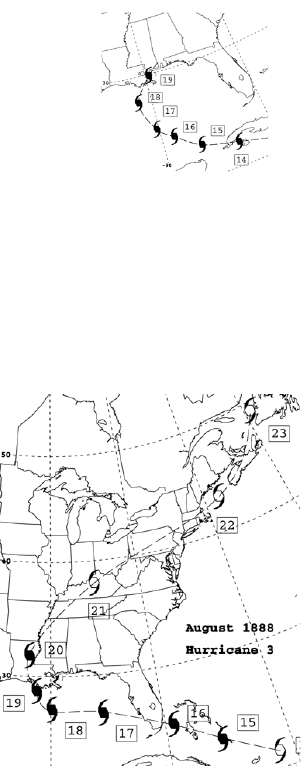
25
October 16-19
th
, 1887: A hurricane struck southeast Louisiana.
On the 16
th
, a strong northeast wind blew across the area. Winds
continued strong until the 18
th
, when winds rose to “a regular storm”.
Rain was steady until the 19
th
when skies cleared, but the wind
remained. The cyclone caused much destruction in New Orleans,
where the pressure fell to 29.22"; they received their heaviest rain in
years.
Great damage was done to cane and cotton crops around Abbeville. Iberville Parish had
considerable damage to area outhouses and the sugarcane crop. In Algiers, trees were blown
down. Such flooding occurred that people had to “wade to work”. On the 29
th
, a call went out
in the Abbeville Meridional for the formation of a “New State Weather Service” for Louisiana;
over twenty states had formed such an organization under the U.S. Signal Corp as of that time.
August 18-20
th
, 1888: The “severest and most extensive”
hurricane that had impacted Louisiana since the Racer’s Storm
in 1837 affected much of northern Gulf coast (track on the left).
In New Orleans, all electric light, telegraph, and phone wires
went down on Sunday night. The height of the storm was
Monday morning. Winds of 90 mph howled through New
Orleans.
The Teche also felt the storm. Sugar houses and sheds were
blown down. Franklin had many homes with roofs blown off
and leveled. Two churches in Morgan City were almost
demolished. Local wharves were also damaged. The rice crop
suffered severely. Much wind damage was noted in
Plaquemines, St. James, Donaldsonville, Houma, Convent, and
Tigerville (which was renamed Gibson two weeks later after
the senior Louisiana Senator in power at the time).
Rain totals of three to four inches were common across southern and central Louisiana. New
Orleans set a 24 hour rainfall record for August on the 19
th
, when 8.9" of rain fell; 14.14" was
measured that week. Almost the whole city was submerged during the tempest. Maurepas had
11.48" of rain. All this water led to extensive flooding in Mandeville.
Rice, sugarcane, corn, and cotton crops were a total loss in sections of southern Louisiana.
Grand Coteau lost much of its fruit crop. Several churches and homes were completely
destroyed. Steamboats and sail boats were driven ashore. The steamers Keokuk, W.G. Little, and
Laura sank during the tempest. Trees were uprooted across the area. Several people perished in
the storm. Damage ran about $2.7 million with the worst occurring in southeast Louisiana. Half
the total was due to crops, another third due to coal sunk in New Orleans harbor.

26
September 22
nd
, 1889: A hurricane accelerated northeast out
of the Gulf of Mexico and struck the southeastern tip of the state
near Venice before moving into the western Florida panhandle
(track on the right).
September 6-8
th
, 1893: This hurricane produced a great
amount of damage to a small area of the state as it moved northeast
out of the Gulf of Mexico into southeast Louisiana. Lockport in
Lafourche Parish was partially destroyed; the storm there lasted
from the night of the 6
th
until the afternoon of the 8
th
. Abbeville
saw a stiff east breeze on the 7
th
that became a gale that afternoon
and evening with heavy rain; over five inches in all.
The heaviest rains were confined to southeastern sections of the
state; highest totals were from Franklin (15.20") and
Donaldsonville (10.69"). Twenty-four hour rainfall records were
set for the month of September at Donaldsonville (7.74" on the 7
th
), Emilie (8" on the 6
th
), and
Wallace (9.29" on the 7
th
). St. Martin and St. Mary Parishes had the worst losses in the state to
cotton, rice, and sugar. Oranges saw extensive damage in eastern Feliciana Parish.
The Deadliest Hurricane in Louisiana History:
Chenier Caminanda, October 1893
October 1
st
-2
nd
, 1893 (Chenier Caminanda
Hurricane): An unheralded storm of great violence
moved from the Gulf across the southeastern United
States (track on the right). It devastated about 500 miles
of coastline from Timbalier Bay to Pensacola.
Settlements along Lake Borgne, the Lower Mississippi,
and the islands along the coast from the mouth of Bayou
Lafourche east to the Chandeleurs saw the brunt of the
hurricane. Landfall was between New Orleans and Port
Eads on October 1
st
. Winds of 100 mph were estimated
at Grand Isle and at Pointe a la Hache. High winds were
noted as far west as Abbeville. A schooner four miles
north of Pascagoula reported a pressure of 28.65".
At dusk on the 1
st
, hurricane force winds overspread the coast. At 10 PM., as winds
continued to increase, water began covering the coastal island. A gigantic wave then crashed
27
upon the shore of the north end of Grand Isle, destroying all before it. Winds went calm between
11 PM and midnight, as the eye passed overhead. Winds increased out of the north thereafter,
before tapering off by dawn.
Areas from Bayou Lafourche to the Balize received the wrath of this hurricane. New Orleans
itself was flooded. Buras was nearly completely destroyed, as only two homes were left
standing. Their Catholic church was swept off its pillars and left in ruin; it would be 12 years
before it was rebuilt. The towns of Neptune, Ostrica, Point Pleasant, and Doullut experienced
major damage. Sixty percent of Plaquemine parish’s orange crop was destroyed.
Bohemia ceased to exist. Quarantine station was completely leveled. Grand Prairie, Home
Place, and Venice also suffered greatly. The St. James chapel in Nicholls was razed to the
ground. The Point a la Hache courthouse saw $5000 in damage. Total damages exceeded
$21,000. After the storm, many of the survivors from Chenier Caminanda moved to Lafourche
parish and founded the town of Leeville. Others settled in Grand Isle, Cut Off, Golden Meadow,
and Lockport (Armstrong).
The storm surge was as high as 15 feet in Louisiana Bays, 16 feet at Chandeleur Island. The
Barataria Bay lighthouse was almost destroyed. The Chandeleur Island lighthouse suffered a
several foot tilt; waves at times washed over the lantern which was 50 feet above sea level.
Severe damage was dealt to the Lake Borgne lighthouse; its roof sheared off by the wind. Hotels
and summer homes on Grand Isle no longer existed. Two thousand people died (779 from
Cheniere Caminanda and 250 from Grand Lake); actual counts of dead at the time ranged from
1848 to 2448. Immense destruction of shipping occurred, islands were stripped of vegetation,
and property losses near $5 million were seen with the storm. Four churches were blown down
across the state. In stature, it was considered more than an equal to the 1856 hurricane.
Two hundred survivors sought refuge at the Port Pontchartrain lighthouse, and its female
light keeper was publicly recognized for this act. One of the survivors was rescued from a
makeshift raft off the South Pass of the Mississippi River eight days later, almost 100 miles from
where he started in Cheniere Caminanda. The schooner Elmira capsized in Buras, but was
driven seven miles upstream to Point Pleasant due to the force of the storm surge. Also of
interest, a man named Jean Henriot wrote a poem about the storm. He was a resident of that
island at the time and left the island to settle in Westwego soon after. The poem was handed
down from generation to generation, before finally fully appearing in print in 1973 (Plaisance).
Another poem about this hurricane was published in the Daily Picayune in October 1893.
September 12-13
th
, 1897: A hurricane struck the Louisiana coast south of Port Eads, then
moved west-northwest into southeast Texas as a significant tropical cyclone on the 13
th
, an event
that would be repeated in 1940 (track on left). Winds were 72 mph at Port Eads. In Abbeville,
winds were stiff out of the east on the 12
th
. The storm vented its fury between dusk and 10 PM,
waning after 11.

28
Damage was inflicted upon the pear, pecan, cotton, and rice
crops. At Cheniere Au Tigre, boats and schooners were badly
damaged and washed up on the beach. Wind mills were blown
down. Area cattle sought refuge on Pecan Island. At Calcasieu
Pass, the only damage noted was to cotton and growing crops.
September 7-9
th
, 1900 (Galveston Hurricane): This strong
hurricane invaded Galveston with deadly results. This storm
also affected Louisiana while on its way to Texas (track on
right). Cameron Parish saw hurricane-force winds. Johnson
Bayou was inundated by the storm surge, but there was no loss
of life. Between that night and the 9
th
, winds in Abbeville were
strong out of the east. Gale force winds spread as far inland as
DeRidder and as far east as New Orleans. Tides in the
surrounding bayou were the highest since the Indianola
Hurricane in 1875. Rice was threshed by the wind. Winds
only reached 31 mph out of the northeast at Port Eads. At
Cheniere au Tigre, a few calves drowned. Damage was
considered light, compared to what happened in Texas.
Hurricanes of the Early Twentieth Century
August 14-15
th
, 1901: A hurricane formed northeast of Puerto Rico and moved west through
Southern Florida and the eastern Gulf of Mexico. The cyclone turned northward, moving ashore
Grand Isle on the 14
th
. The 5-min average winds reached 56 mph at Port Eads before the
anemometer blew away and a 24 hour rainfall record was set there for the month of August,
7.64”. River stages along the Mississippi river at New Orleans rose to a level of seven feet
during the storm, producing much flooding. Levee breaks around New Orleans flooded the city.
Buras reported 4 feet of water in town. The only building not destroyed at Port Eads was the
lighthouse. Total Louisiana damages exceeded $1 million. Ten lives were lost.
September 25-26
th
, 1906: This hurricane moved westward through the Caribbean before
turning north-northwest through the Yucatan Channel. The system made landfall at the Mouth
of the Pascagoula River. Gales were experienced along the Lower Mississippi Delta. Winds
gusted to 49 mph as the pressure fell to 29.15" at New Orleans. The Lake Borgne lighthouse was
most likely destroyed in this storm, though Cipra dates the destruction as occurring on the 10
th
(Cipra). A 24-hour rainfall record was set at Collinston for the month of August, when 4.55”
accumulated on the 25
th
.
July 21
st
, 1909: The hurricane that caused great damage across Texas also left its mark on
southwest Louisiana. Gale-force winds affected Cameron and Vermilion Parishes, on top of the
storm surge. Hundreds of cattle drowned in the marsh. Cotton from Grand Chenier to Sabine
Pass was in ruin. Two lives were lost in Cameron Parish.

29
On September 20-21
st
, 1909, a hurricane passed over Berwick Bay before passing inland
between Baton Rouge and New Orleans. Winds of 80 mph were reported at Thibodaux. The
pressure at Abbeville bottomed out at 28.68". Extensive damage occurred in New Orleans to coal
barges, railroads, communication lines, crops, and much property public and private when winds
reached 66 mph at 7 PM. Churches in Smoke Bend, Kaplan, Montegut, Pierre Part, and Elton
were damaged. Crowley saw a 35% loss to its rice crop. Cotton and sugarcane suffered greatly
across greatly across Southwest Louisiana, east of the Calcasieu River. Almost every mill in
Iberia parish sustained damage. About 20% of the cotton crop was damaged.
Significant delays to rail traffic were caused by wreckage strewn across the line from
Avondale westward to Morgan City and New Iberia. The launch Maine was sunk in Grand Bay
during the tempest. Many sailing vessels were swept ashore near the Rigolets. Damages totaled
$6 million. The storm killed 353 people and its 15 foot storm surge inundated much of southern
Louisiana.
June 1912: A tropical storm with 60 mph sustained winds moved inland into south-central
Louisiana. The Teche rose 4.5 feet in only 24 hours, flooding sugar crops for up to three days
(Wade).
August 15-19
th
, 1915 (Saltwater Storm): A hurricane made landfall just west of Galveston.
Gales howled throughout Cameron and Vermilion Parishes... and as far east as Mobile. Produced
tides of 11 feet at Cameron (called Leesburg at the time), ten feet at Grand Cheniere, and 9.5 feet
at Marsh Island; Grand Isle reported water 6 feet deep across the city. This Gulf intrusion
flooded the Chenier plain of southwest Louisiana and southeast Texas, leading to the demise of
Cameron parish’s orange-growing industry (Gomez). Heavy rains also fell across the state, as
seen on the table to the right.
The lightkeeper at the Sabine Pass lighthouse
had to turn the lens by hand, as vibrations caused by
the wave action put the clockwork out of order. At
Sabine Bank, 17 miles offshore the Mouth of the
Sabine, damage was noted. Damage estimates for
Louisiana and Texas totaled around $50 million.
Twenty-four hour rainfall records
For August set during the 1915 storm
Merryville 17
th
8.71”
Logansport 18
th
7.37”
Plain Dealing 19
th
3.81”
Liberty Hill 19
th
2.92”
Septemb
er 29
th
, 1915: A violent hurricane reached New Orleans after tracking through the
Caribbean and Gulf of Mexico on a parabolic course. The ten foot high levee protecting the city
at the time began to be questioned as not being high enough after the passage of this storm
(Orleans Levee District). The pressure fell to 28.01" on a ship in the New Orleans harbor.
Burrwood's winds reached 140 m.ph. for five minutes and were sustained at or above 107 mph
for two straight hours (Cline). New Orleans saw as high as 98 mph. Franklin had 14.43" of rain
during the storm, while New Orleans saw over eight inches. Nearly every building in New
Orleans received damage. Over 50% of U.S. Highway 90 along the Mississippi coast was
destroyed.

30
Storm surges up to 12 feet ran ashore the northern
coast of Grand Isle and 13 feet at the west end of
Lake Pontchartrain. The New Canal lighthouse was
heavily damaged as winds of 130 mph raged, and the
pressure fell to 28.11", which at the time set a record
for the lowest pressure measured on land in the
United States (Cipra). Ninety-nine out of 100
buildings were destroyed in the town of Leeville.
The sugar crop was damaged. Thirteen million
dollars of damage, $5 million in New Orleans alone, were caused and 275 people died. Many of
those who perished refused to leave low lying areas in advance of the storm, despite ample
warning.
October 17-18
th
, 1916: A large hurricane hit
Pensacola after accelerating northward through the
Gulf of Mexico. Gale-force winds lashed Lower
Plaquemines Parish. The storm produced damage as
far west as Burrwood. Heavy rains fell statewide,
with Burrwood receiving nearly a foot of rainfall.
Twenty-four hour rainfall records
For September set in 1915 hurricane
Franklinton 30
th
10.28”
Paradis 29
th
9.00”
Pearl River 30
th
6.60”
Hammond 30
th
6.40”
Dutchtown 29
th
3.50”
Twenty-four hour rainfall records
For October set in 1916 hurricane
Burrwood 17
th
7.95”
Franklin 17
th
5.90”
Napoleanville 16
th
4.61”
Collinston 18
th
3.41”
Kelly 13
th
3.13”
August 6
th
, 1918 (Merryville Tornado/Cheniere-au-Tigre Storm): A hurricane originating
south of Jamaica struck Cameron Parish. The storm affected places as far west as Orange, Texas
and as far east as Jennings. It struck without warning. Winds at Lake Charles were estimated to
be near 100 mph; Sulphur reported a pressure of 28.36" and winds as high as 125 mph. Johnson's
Bayou saw a 2 1/2 foot storm surge while Morgan City recorded a three foot surge. Leesburg
(Cameron) itself saw little damage. However, homes in Grand Chenier and Creole were swept
away by the storm surge.
The main route between Leesburg (Cameron) and Lake Charles was a ship named the
Borealis Rex. It left on the morning of the 6
th
and fought rising winds to try to get back to port in
Lake Charles. When she entered Prien Lake, strong winds drove the boat against the shore. The
passengers ran out to a nearby home to ride out the storm. When winds reversed out of the north
in the early afternoon, the Rex was forced a mile downstream where it sank in 8-10 foot waves.
Lowest pressure noted on the vessel’s barometer before capsizing was 29.06”. The boat was
resurrected, refurbished, and back in commission by the spring of 1919. Its bell ended up at the
Methodist church until it was blown off the roof by severe thunderstorms on February 12, 1998.
The tempest killed three pilots at Gerstner Field, one of the first air fields in the country,
which was located near Holmwood. It destroyed seven hangars and 96 airplanes. Only its Big
lake Gunnery School survived, which assisted with relief work after the storm. In Lake Charles,
the synagogue Temple Sinai was severely damaged. The old Presbyterian church was
31
demolished. A portion of the M.E. church was detached and “blown to pieces” (Millet). Area
sawmills were destroyed. The damage was most severe in the Goosport milling district, where
fires added to the destruction caused by the wind. The fires were so bright that DeQuincy could
see a red glow in the southern sky.
Westlake was "a scene of desolation" as most buildings were leveled. Very few Sulphur
businesses were left standing. The Union Sulphur Mines saw the greatest monetary losses, which
totaled $3 million. Further north, DeQuincy was heavily damaged by high winds. Several homes
and businesses there met their fate. Thirty- four lives were lost across the state of Louisiana.
Timber losses were calculated at $1 million, while the destruction of the saw mills incurred a
loss of $1 million. In all, $5 million dollars in damage occurred.
September 11-14
th
, 1919: A hurricane moved westward off the coast of Louisiana. Gales
were experienced in Lower Plaquemines parish. The pressure at Burrwood fell to 29.60" as
winds peaked at 52 mph. Lake Pontchartrain became a "raging sea". A six foot storm surge was
recorded 40 miles west of Grand Isle, and lesser invasion of the coast was seen elsewhere in the
state. This system went on to devastate Corpus Christi, and was similar to Carla of 1961 in
effects across Louisiana.
September 21-22
nd
, 1920: A hurricane moving through the western Caribbean sea, making
landfall in Honduras and the Yucatan peninsula before moving north-northwest through the
central portion of Louisiana. The pressure fell to 28.99" at Houma. Fishing villages along Lake
Borgne experienced gales on the east side of the system, at times gusting to 48 mph. Trees were
uprooted and lines were downed. As one of the lines fell, a man fell victim. Winds of 60 mph
were seen as far east as Bay St. Louis. Winds reached 90 mph at Grand Isle. A twenty-four hour
rainfall record was set at Kelly for the month of September when 1.60” was recorded on the 22
nd
.
The sugar crop was damaged. Tides up to six feet were reported in the Mississippi Sound. Tides
did considerable damage at Grand Isle and Manilla Village. The storm killed one and produced
$1.45 million in damage.
October 16
th
, 1923: This minimal hurricane hits state near the Mouth of the Mississippi river.
Heavy rains were seen eastward to Pensacola. The pressure fell to 29.25" at Morgan City and the
tide rose 3.6 feet. As the storm accelerated north and northeast, rains spread north to Lake
Superior.
August 25-27
th
, 1926: A hurricane struck near Houma. The steamship Cody, while lying 220
miles east southeast of Galveston reported 75 mph winds while the Argon saw northeast winds
of 100 mph near 27N 90.5W. The pressure bottomed out at 28.31" in Houma with estimated
winds of 100 mph at Grand Isle. Morgan City witnessed 60 mph winds howl through town. Over
five inches of rain fell. New Orleans gusted to 52 mph as the pressure sank to 29.37".
Burrwood's winds peaked at 50 mph while the pressure fell to 29.55".
At Houma, the sugarhouse was wrecked at Southdown plantation. The Episcopal church was
"smashed". Ninety percent of the sugar cane was gone after the storm. Serious damage occurred
between New Orleans and Baton Rouge. Lutcher, Caryville, Burnside, and Gismer saw streets
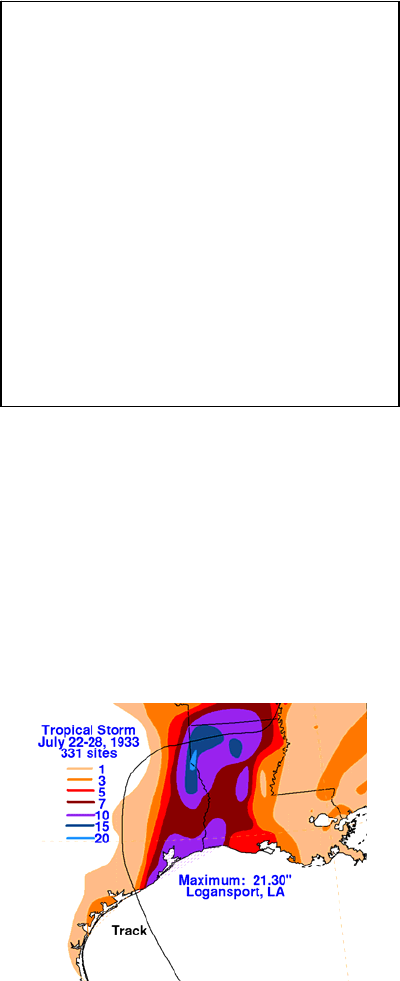
32
full of wreckage which became nearly impassable.
Many trees were uprooted and barns were removed
from their foundations. Thibodaux and Napoleanville
experienced winds of 120 mph. Houses fell as
telephones splintered in the wind. The town of
Thibodaux lost three churches, a warehouse, and ten
stores.
At Glenwood and Madewood, more than thirteen
inches of rain fell in less than 12 hours. Rainfall
records set during the cyclone are listed on the right.
The pecan orchard in Shriever was gone. Early rice
and cotton were beat down at Crowley. Baton Rouge
plunged into darkness as $20,000 in damage occurred
to its electric company. More than seventy passengers
from the Southern Pacific trains were marooned on a
Twenty-four hour rainfall records for
August set during the 1926 hurricane
Donaldsonville 26
th
14.47”
Avoca Island 25
th
12.06”
Pearl River 26
th
8.60”
Morgan City 25
th
8.50”
Franklin 26
th
8.45”
Houma 25
th
8.04”
Baton Rouge 26
th
7.50”
Cinclare 26
th
5.56”
Amite 26
th
5.34”
Reserve 26
th
5.20”
Clinton 25
th
5.00”
railway ferry barge in the Mississippi when two tugboats towing it grounded.
A boat sank at Donaldsonville. The New Canal lighthouse was again damaged, instigating a
project to raise the structure by three feet after the storm. The third Timbalier Bay lighthouse was
tipped to the northwest. A ten foot storm surge was reported at Timbalier Bay; tides as high as 15
feet overwashed the southern coast of Terrebonne Parish, north of Isle Derniere. Twenty-five
people died and four million dollars in building damage occurred as it moved northwest towards
Shreveport.
July 22-28
th
, 1933: Originating in the Caribbean
sea, this cyclone crossed the Yucatan peninsula as a
tropical storm on July 20
th
, this tropical storm moved
northwest into the middle Texas coast late on the 22
nd
near Matagorda Bay. The storm then tracked slowly
eastward after reaching northeast Texas for several
days and brought heavy rainfall as it moved slowly
inland across northeast Texas and northern Louisiana
as an extratropical low. An area of over 25,000 square
miles saw an average of 12.5", mainly across the
northwest half of Louisiana and the east portion of the
Piney Woods of Texas. A small area of the central Texas/ Louisiana border measured over
twenty inches of rain. Logansport recorded 21.3" over a four day period, with 18 inches falling in
one day, setting a 24-hour rainfall record for July at that location. San Patricio creek, north of
Converse, went on a rampage, ceasing railroad and highway traffic through the area. A severe
thunderstorm struck Alexandria at 3:45 am on the 25
th
, breaking windows, downing trees, and

33
damaging area roofs. Rainfall at Alexandria reached 9.75” on the 25
th
which set a 24-hour
rainfall record for July. Northwest Louisiana would not see a rain event of its equal from a
tropical cyclone until June-July 1989 (Allison).
June 16-17
th
, 1934: Morgan City was hit by this hurricane. Not a single building there
escaped unharmed. Chimneys tumbled, roofs were torn off, and numerous windows were
smashed. Winds blew between 75 and 100 mph at Morgan City. Baton Rouge experienced 60
mph winds uproot trees and halt work on the state capitol. Pressure fell to 28.52" at Jeanerette.
Winds only reached 35 mph at New Orleans, where the pressure fell to 29.34".
Twenty-four hour rainfall records
set during the June 1934 storm
Lafayette 17
th
9.68”
Franklin 16
th
8.65”
Melville 17
th
7.10”
Abbeville 17
th
5.00”
Heavy rains deluged the state. Effects from
the
hurricane were felt as far east as Gulfport, Mississippi.
To the north of Ferriday, the local American Legion
post was unroofed. Stormy weather extended as far
north as Memphis, Tennessee. A storm surge of 12 feet
inundated the region around Oyster Bayou. Boats ran
aground as the Gulf invaded the state from the south.
The storm killed seven and produced $2.6 million in
damage.
August 14-16
th
, 1938: A hurricane which hit the
shoreline east of Cameron caused $250 thousand worth
of damage in Louisiana. The Coast Guard cutter
Saranac played a vital role as it relayed coastal
conditions throughout the tempest. The fury of the
storm struck Cameron at 6 pm and Lake Charles at 8
pm on the 14
th
. Trees were uprooted throughout
Cameron parish. Grand Chenier reported winds of
hurricane force. Lake Charles recorded a pressure of
29.56" and wind gusts to 60 mph around 7:30 PM. The
greatest damage to the city occurred in the Goosport
and South Ryan areas.
Jennings measured a 13.88” deluge on the 15
th
. The
Old Spanish Trail (U. S. Highway 90) became
impassible due to the flooding east of Welsh. Homes
flooded in Grand Marais, southeast of Roanoke. Storm
surges along the southwest Louisiana coast were four to
five feet. Shrimp boats were reportedly beached near
Creole. The Intracoastal Ferry, loaded with four cars
and 20 people, broke its cable and “whirled
downstream,” crashing onto the river bank after
traveling one-half mile. One person died in Lake
Jackson.
Twenty-four hour rainfall records
set during the August 1938 storm
Jennings 15
th
13.88”
Ville Platte 15
th
10.50”
Cheneyville 15
th
9.76”
Jonesville 16
th
7.98”
Urania 15
th
5.85”
Alexandria 15
th
3.85”
Pollock 15
th
3.36”
Monroe 15
th
3.12”
Bastrop 15
th
2.71”
Colfax 18
th
1.74”

34
August 6-10
th
, 1940: This hurricane with sustained
winds of 80 mph created a path of damage as it
traveled slowly offshore the coast of Louisiana into
southeast Texas. Hurricane-force winds only extended
ten miles on either side of the storm. Several feet of
water from the Gulf of Mexico invaded Grand Isle,
while fifteen feet of water inundated sections between
there and Golden Meadow. Cameron went under two
feet of sea water. Calcasieu Pass reported at 4.8 foot
storm surge and western portions of Lake
Pontchartrain saw a 6.4 ft. surge. Lake Pontchartrain
churned into a “foaming mass.” Part of the bridge
between Thunder Bayou and the nearby chenier was washed away. Railroad tracks were
flooded east of New Orleans.
Southeast Louisiana was raked by “strong, puffy
winds”…at New Orleans they peaked at 53 mph.
Sugar was left in ruin in Houma. Pressures fell to
29.35” at Burrwood and Grand Isle. Several houses at
Delacroix Island and Shell Beach were leveled by the
winds. Gale-force winds overspread southwest
Louisiana, with winds reaching 48 mph at Lake
Charles. Winds at Cameron reached 70 mph while
their pressure fell to 29.10” at 7 am on the 7
th
, making
it their strongest storm since October 1886. Thirteen
oil derricks were blown down in the Cameron
Meadows oil field, located eight miles northeast of
Johnson’s Bayou. Due to the high winds and frayed
nerves of the residents tying up the phone lines, ham
radio became the only reliable method of
communication during the storm…a method of
communication still used during storm situations.
Twenty-four hour rainfall records
For August set during the 1940 storm
Crowley 9
th
19.76”
Lafayette 9
th
19.63”
Gueydan 8
th
17.60”
Abbeville 9
th
17.50”
Grand Coteau 9
th
16.07”
Lake Arthur 9
th
11.60”
Melville 9
th
9.40”
Hackberry 8
th
9.12”
Lake Charles 8
th
8.91”
Pecan Island 7
th
8.09”
Atchafalaya 9
th
8.00”
Leesville 8
th
7.58”
Schriever 7
th
6.05”
W
hen the winds began to slacken, torrents of rain fell across southern Louisiana, with over
half of the state reporting five inches of rainfall. Debilitating flooding was endured across
Acadiana with Crowley receiving 33.71" of rain over a five day period (Aug 6-10). Other
locations receiving high rainfall totals included Abbeville (31.66”) and Lafayette (29.65”).
Lafayette received 19.63” during their wettest 24 hour period. Miller Island reported 37.5" of
rain, with 23.8" within a 24 hour period. Rainfall records at the National Weather Service office
in Lake Charles were set for August 7
th
and 8
th
which still stand today (6.77" and 4.84"
respectively), with 8.91” falling within a 24 hour period. Entire towns and cities were evacuated
35
through the 12
th
due to the flooding. Gueydan went under six feet of flood waters. The business
district of Crowley was submerged by two feet. Bayous flooded within St. Landry parish, with
refugees fleeing to Opelousas. The flooding was described as worse than during the 1927
crevasse within Acadiana. Almost 2 million acres of land went underwater by at least one foot.
Low areas remained inundated until mid-October (LMRCSCC II). A raging fire in the town of
Iowa burned down Shell Oil’s district offices and supply warehouses as it could not be fought
due to the flooding in its vicinity.
Pecans were “shredded.” Both flora and fauna were forever altered by this environmental
catastrophe. Cotton and corn crops experienced significant losses. Large losses were also seen
in the sugar crop in the Teche. Huge losses to area livestock and muskrats (75,000 head) were
caused by the massive flooding. The flock of dwindling whooping cranes was scattered across
southwest Louisiana. By 1947, only one remained. Nutria, being farmed in Acadiana for their
pelts, escaped their farms and began their coastal expansion (Gomez).
The schooner J.W. Clise was abandoned during the cyclone 135 miles south of the Mouth of
the Mississippi; its crew was rescued. A barge laden with pilings for use in construction
overturned near the Southern Yacht Club in New Orlenas. Damage totaled $9 million, but only
six lives were lost. An evacuation of 18,000 people from the flood zone most likely limited the
death toll. The press in southwest Louisiana attributed the low loss of life to good preparation by
residents due to guidance from the newly-opened Weather Bureau office, then housed east of
Lake Charles at the Calcasieu parish airport (now known as Chenault field).
September 22
nd
-24
th
, 1941: This hurricane which struck Texas City, Texas caused hurricane
force winds to move through western Cameron parish. Winds gusted to 60 mph at Lake Charles,
where the pressure fell to 29.48". Tides rose to 4.8 feet above mean lower low water at
Cameron. Glenmora astablished a new 24-hour rainfall record for September (3.50”). The
Calcasieu river flooded slightly near Cameron due to backwater flooding. The Old Spanish Trail
(U.S. Highway 90) flooded between Lake Charles and Westlake.
August 19-22
nd
, 1942: A hurricane paralleled the shore before moving westward into
Galveston. Hurricane-force winds raged in the vicinity of Johnson’s Bayou. Winds only gusted
to 28 mph at Lake Charles, where 2.12" of rain fell. Other locations measured greater rainfall,
with new 24-hour rainfall records for August becoming established at DeQuincy (2.25” on the
21
st
), Monroe Dam (3.18” on the 19
th
), and Rodessa (8” on the 22
nd
).
July 25-28
th
, 1943: This hurricane which surprised Houston and led to the era of hurricane
reconnaissance first formed off southeast Louisiana. Burrwood reported 36 mph winds from the
northeast, first indicating the incipient tropical storm on the 25
th
. Winds gusted to 36 mph at
Lake Charles on the 27
th
. Gales were seen to the south and west of Lake Charles. Heavy rains
fell at DeQuincy, with 7.65” on the 28
th
alone.
September 15-19
th
, 1943: A dying tropical storm made landfall in southern Louisiana, east
of Lake Charles. Storm tides reached four feet in Lake Pontchartrain. Very heavy rain occurred
throughout Southern Louisiana, with 19.26" falling at Morgan City. A number of 24-hour

36
rainfall records for the month of September were set, including Chandaleur Lighthouse (12.25”
on the 18
th
), Pecan Island (9.55” on the 17
th
), and Belle Chasse (8.57” on the 18
th
).
August 22
nd
, 1947: A hurricane passed offshore Grand Isle. Sabine Pass reported a 3.6 foot
storm surge as the storm hit the Upper Texas coast.
September 19-20
th
, 1947 (George): The Weather
Bureau forecast office in Miami, while operating with the
military, named this hurricane George. Naming began in
the Pacific Fleet during World War II as a method of
discerning one storm from another. This system of
naming was unofficially continued by the Weather
Bureau until 1953, without being highly publicized
(Barnes).
This category two hurricane with an eye 25 miles in
diameter passed directly over New Orleans. Hurricane-
force winds first reached the Mississippi and Louisiana
shores at 6 AM and New Orleans at 8 AM. During its
second year of operation, wind gusts to 125 mph were
estimated at Moisant International Airport (highest gust
measured was 112 mph) and the pressure fell to 28.57".
Twenty-four hour rainfall records
set during the 1947 hurricane
Bogalusa 20
th
6.06”
Pollock 20
th
4.88”
Weyanoke 19
th
4.80”
Winnfield 20
th
4.52”
Gum Springs Tower 20
th
4.33”
Montgomery 19
th
4.20”
Hickory Grove 19
th
3.93”
Urania 20
th
3.92”
Riverton Dam 20
th
3.83”
Columbia 19
th
3.41”
Grand Cane 20
th
3.00”
Monroe Dam 20
th
2.52”
Sterlin
g
ton Dam 20
th
2.00”
As the storm passed over Baton Rouge at 2:15 PM, Harding Field saw sustained winds of 96
mph, with gusts estimated at 120 mph. Hurricane-force winds reached as far inland as Melville
by 4 PM. Lafayette experienced squalls to 45 mph and a pressure of 29.37” while the storm was
located over southeast Louisiana. Lake Charles gusted to 48 mph with a lowest pressure of
29.35”.
A 15.2 foot storm surge overcame the Bay St. Louis seawall, spreading saltwater from the
Gulf of Mexico well inland. Ostrica saw an 11.5 foot surge and Shell Beach experienced an 11.2
foot storm surge. Water was up to six feet deep in Jefferson Parish over a 31 square mile area.
The air fields at Moisant were under two feet of water, closing the airport. This storm
demonstrated the dire need for tidal protection levees for New Orleans. Much of the city (8.9
square miles) was flooded, and $110 million in damage was produced. A small sailboat broke
from its moorings at the Southern Yacht Club and broke up against the Lake Pontchartrain
seawall The storm claimed 51 victims, 12 in Louisiana.
September 3-4
th
, 1948: A hurricane moved ashore Timbalier Bay. Moisant International
Airport observed 90 mph gusts as the pressure at the Huey Long Bridge fell to 29.21". Trees
were uprooted in New Orleans. Heavy damage was done to oil rigs and other equipment offshore
Grand Isle. Grand Isle was cutoff from the mainland when five feet of water flooded area
roadways. Crops suffered wind and rain damage. Heavy rains fell at Amite (4.60”), Covington
(7.20”), New Orlenas (4.29”), and Reserve (5.80”) on the 4
th
. Storm surges of five feet occurred
at Ostrica Lock and 4-5 feet along the Chandeleurs. Damage estimates were near $888 thousand.
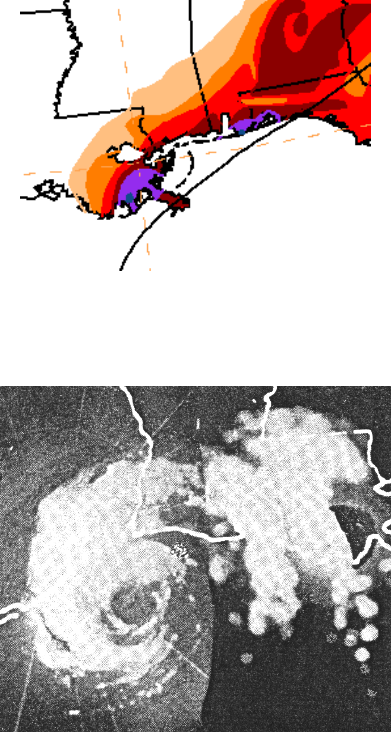
37
Late Twentieth Century Hurricanes
September 24
th
, 1956 (Flossy): Hurricane Flossy
completely submerged Grand Isle and caused extensive
coastal erosion as it moved across the Mississippi Delta.
Burrwood reported winds to 90 mph and a lowest
pressure of 29.03." Rain totals were excessive across
southeast Louisiana, with a maximum of 16.70" at
Golden Meadow. Hundreds lost their homes in the
storm. Cattle were drowned and citrus, sugar cane, and
pecan crops were heavily damaged. The eastern sections
of the New Orleans seawall were overtopped, flooding
2.5 square miles. A storm surge of 13 feet was seen at
Ostrica Lock. The storm killed 15 and $22 million in
damage was produced.
June 27
th
, 1957 (Audrey): The most destructive
hurricane to strike southwest Louisiana was Audrey.
She formed in the southwest Gulf of Mexico and moved
due north, becoming the strongest hurricane ever to
form in June. Warnings were issued 24 hours before
landfall. However, the storm sped up its forward
motion overnight on the 26
th
, catching residents and
meteorologists alike in the area by surprise. Audrey
moved ashore near the Texas/Louisiana border on the
morning of the 27
th
causing a disastrous storm surge.
Picture to the right, courtesy of the U.S. Air Force, is a
radar composite from early on the morning of June 27
th
.
Gulf waters began to surge ashore during the early morning hours. Some in Cameron fled to
the courthouse…the only structure that survived Audrey. Others were more unfortunate. Wood-
frame houses floated like boats inland, in some cases, landing many miles away from their
original location. Most were found along the Intracoastal Waterway after the storm. Over 1.6
million acres of land were flooded by the storm surge and headwater flooding along the rivers of
southwest Louisiana. The storm surge began to recede early that afternoon. Many who survived
the storm rebuilt, but few were placed on pilings. Storm surges of six feet of more extended
from Galveston, TX along the coast to Cocodrie, LA. The highest storm surge measured was
12.4 feet west of Cameron. In Vermilion Parish, the storm surge pushed inland to Perry, just
south of Abbeville, and put Pecan Island under feet of saltwater. Much of St. Mary Parish was
also inundated by Audrey. Waves associated with the storm were monstrous, indeed. In the
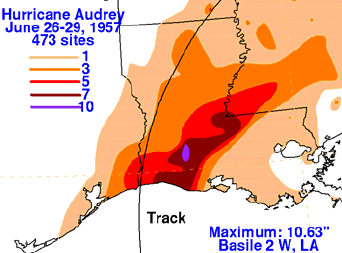
38
Gulf, seas of 45 to 50 feet were reported. Waves at Cameron reached as high as 20 feet above
mean sea level; this was on top of the storm surge.
Hurricane-force winds were experienced from Port Arthur, Texas eastward to Mobile,
Alabama. Highest winds were reported to 96 mph at the NWS site at the Lake Charles Air Base
(now Chenault Field) with reports up to 105 mph in Lake Charles. A pressure of 905 hPa, or
26.74”, was reported by offshore oil platforms as Audrey neared the coast. An unofficial report
of 185 mph winds was received from an oil rig, however this could have been associated with a
severe thunderstorm embedded within Audrey's eye wall. Oil company tenders reported 150 mph
winds which, although they are unofficial, are believed to be reasonably accurate. Rayne saw
major damage to homes, businesses, and crops.
Church Point had many trees uprooted during the storm.
High winds in Baton rouge blew out windows from the
skyscraper Capitol. Two homes on Bayou Grosse Tete
near Plaquemines were blown over (Menard). Heavy
rainfall fell to the east of its track across southwest and
central Louisiana.
Two tornadoes were spawned; one in New Orleans and
the other in Arnaudville. Out of the 100,000 buildings that
experienced damage, several thousand were destroyed.
Between 90 and 95 percent of the buildings in Cameron and Lower Vermilion Parishes were
damaged beyond repair. The shrimp boat Bert H. Walling II sank in the Calcasieu channel below
Cameron, its crewmen rescued. Two 50 foot long fishing boats were thrown onto Main street
(Louisiana Highway 82) in Cameron. An offshore oil rig was shoved ashore, destroying four
fuel storage tanks along the way. The tanker Tillamook had the misfortune of being within the
eye of Audrey between 4 and 10 AM on the 27
th
. In an interesting coincidence, Audrey had the
help of a ship named Audry. This ship of Lake Arthur demolished a home in Cameron on its
way inland.
One of the more curious aspect of the storm was the exodus of wildlife preceding it. On the
evening before landfall, thousands of crawfish were seen fleeing the marshes around Cameron. A
few enterprising locals decided to collect them and put them in their freezer, unaware of the
significance of this event. Needless to say, these crawfish were never brought to a boil the
following day, as planned.
Masses of dead cattle, alligators, snakes, nutria, and muskrats blocked portions of the
Intracoastal canal (Menard). A dead cow was found on top of a telephone pole two days after
the storm moved inland. The total lives lost during Audrey stands at 416; most of them were in
Cameron Parish. Damages in Louisiana totaled $120 million.
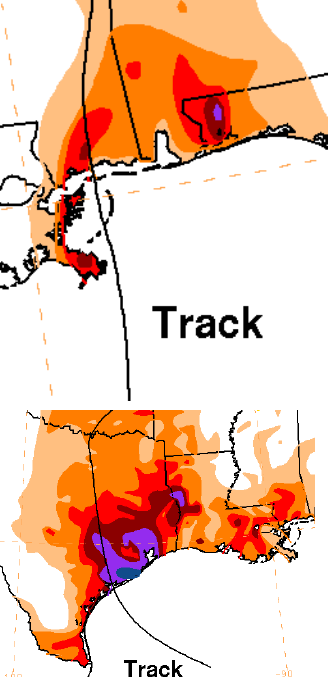
39
September 15
th
, 1960 (Ethel): Hurricane Ethel quickly
developed into a major hurricane the central Gulf of Mexico
before moving accelerating northward along the extreme
southeast sections of the Mississippi Delta, and weakened as
it moved inland at Biloxi. Hurricane-force winds were seen
in Lower Plaquemines parish. Venice had sustained winds of
90 mph with gusts to 104 mph at 4:15 AM. Burrwood saw
gusts to 69 mph. The highest tide noted was seven feet above
mean seal level on Quarantine Bay at 4 AM CST. Storm
surges inundated the coast from the Mouth of the Mississippi
east to St. Marks, Florida. Heavy rainfall was restricted to
near and east of its track within the Mississippi delta, with
the maximum within Louisiana measured at Quarantine,
where 7.45” was measured.
September 11-13
th
, 1961 (Carla): Hurricane Carla
caused severe erosion along the entire coast in mid-
September. Winds gusted to 56 mph at Lake Charles. Ten
tornadoes were spawned across the state. Carla smashed a
$50,000 fishing pier in Holly Beach and a row of houses
along the coast. Road damage reached $300,000. At
Hackberry, a large oil storage tank was displaced 6-7 miles
northwest of its original location. This caused $300,000 in
damages. Grand Isle received flooding, but no structural
damage.
Damage was also seen along the Calcasieu Ship Channel northward to Lake Charles. Some
oil rigs offshore were moved 8 to 10 feet towards the coast, despite being anchored 8 feet deep
into the Gulf bottom. "Storm surges" of over 5 feet were seen along the Mississippi Delta and up
to 7.6 feet at Cameron. In all, 3.6 million acres of land was inundated by the storm. Damage
was seen along the Calcasieu ship channel northward to Lake Charles. A tornado touched down
in Leeswill shortly after dawn on th 13
th
, where six lives were lost. Power outages and heavy
rains were experienced as far east as Baton Rouge. Ten tornadoes were spawned by Carla within
Louisiana. Heavy rains within the state were primarily in west-central Louisiana, with a
maximum of 13.90” measured at Many. This rainfall led to minor flooding along the upper
Calcasieu river. Total damages in Louisiana reached $25 million, even though the Pelican state
escaped the brunt of the cyclone. As the cyclone spun its way through the Midwest, flash floods
struck Kansas and Missouri. President John F. Kennedy declared much of Louisiana a disaster
area, along with Texas, Kansas, and Missouri.
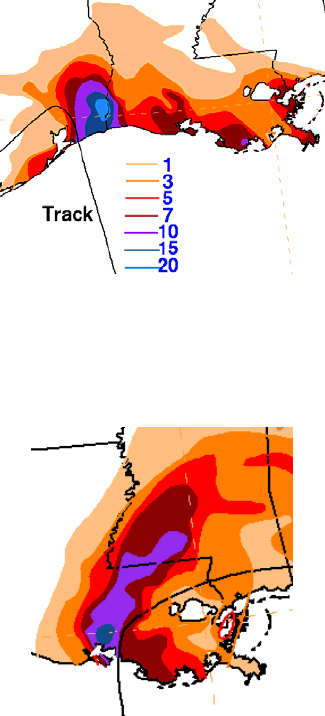
40
September 16-19
th
, 1963 (Cindy): A rapidly developing
storm in the northwest Gulf of Mexico, Cindy moved
northward onto Galveston Island on the morning of the 17
th
.
That afternoon, Cindy moved west to southwest, paralleling
the Texas coastline just inland. Louisiana was in the moist
eastern side of the tropical cyclone which led to heavy rains
west of the Atchafalaya swamp. The rains were badly
needed, as Texas and Louisiana were in the grips of a severe
drought that began in early 1962. An area of over 15 inches
of rain fell over the Sabine Basin in western Calcasieu and
Beauregard parishes, though the absolute maximum fell just
on the Texas side of the border. The only death reported was
of a man who drowned while evacuating an oil rig south of
Cameron. Total damages were estimated at $12.5 million.
October 2-3
rd
, 1964 (Hilda): Hurricane Hilda caused
severe coastal erosion and local flooding, along with 39
associated deaths as it hit Salt Point. Tornadoes were
spawned at Golden Meadow, Galliano, Larose, Kenner,
Metarie, and New Orleans. The Larose Tornado alone caused
24 of the deaths and a staggering 345 injuries. St. Joseph’s
chapel in Lydia was completely destroyed. The 115-year old
St. Nicholas church in Patoutville was left in ruins after the
storm. Sugar cane in the Teche was severely damaged. A
large water tower collapsed on the Erath City Hall, which
killed around ten people.
Franklin reported a pressure of 28.40" and winds estimated at 135 mph. Winds of hurricane
force spread across much of southeast Louisiana. Over ten inches of rain fell across the
Atchafalaya swamp and the southwest corner of Mississippi. Jeanerette measured 17.71" of rain.
New Roads and Baton Rouge saw excessive rainfall amounts over a 24 hour period (10.1” and
8.9” respectively). Between storm surge flooding and fresh water flooding, three million acres
of land were inundated.
The Gulf invaded Cocodrie up to a depth of 7.8 feet and Point Au Fer up to 10 feet. Offshore,
the Oil Driller, 100 miles south of Morgan City, had their anemometer pegged at 120 mph
throughout the night of the 2
nd
/3
rd
. Waves over 50 feet high punished the rig for hours that night.
Damage totaled $100 million.
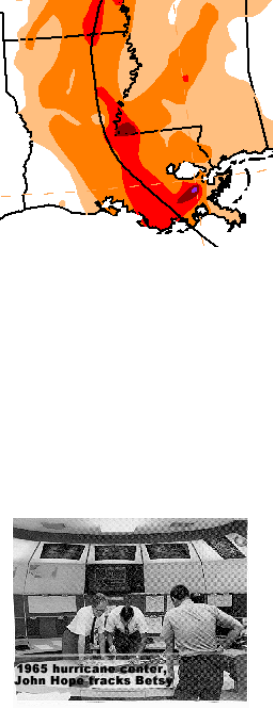
September 9-10
th
, 1965 (Betsy): Hurricane Betsy, after
producing great damage in Florida while meandering
westward in the Florida Straits, accelerated to an unusually
fast forward motion of 22 mph through the Gulf of Mexico,
came ashore Grand Isle as a major hurricane where winds
gusted to 160 mph. The sea level pressure dropped to 28.00"
at Grand Isle and Houma, which up to that time was the
lowest pressure measured within the Bayou state. Port Eads
gauged winds of 136 mph with gusts to 145 mph. Winds
gusted to 125 mph and the pressure fell to 28.75" at New
Orleans on the 9
th
. Winds gusted above 100 mph across much
of southeast Louisiana, and a stripe of over five inches of rain
fell along and east of its track as far north as Tallula.
Hurricane-force gusts reached as far west as Lafayette and as
far inland as St. Landry parish. Alexandria and Monroe
experienced wind gusts in excess of 60 mph. More than
27,000 homes were destroyed statewide by Betsy.
A ten foot storm surge was produced causing New Orleans
its worst flooding in decades...enduring days underwater.
Water depths reached up to nine feet deep in eastern New
Orleans and Chalmette. Grand Isle saw a 15.7 foot surge wash
over its northern coast. Practically all buildings in Grand Isle
were either severely damaged or destroyed. Across Louisiana,
2.4 million acres was inundated by the storm. To the right is a
picture of hurricane specialists working Betsy. John Hope (to
the left) later worked for the Weather Channel in 1982.
Storm surges were seen as far east as Mobile. Hundreds of ships, tugs, and barges were sunk
or driven aground from New Orleans to Baton Rouge. The Mississippi river rose more than 10
feet at New Orleans and crested at 15.5 feet at Baton Rouge. Following the storm, the levee was
elevated to 12 feet by the Orleans Levee Board. Offshore and coastal oil installations, along with
public utilities, reported unprecedented damage. The highest rainfall amount measured within
Louisiana was 12.21” in New Orleans at Callender Field. Fall crops were in ruin, particularly
sugar cane, cotton, and pecans. Many livestock drowned. Damage throughout southeast
Louisiana totaled $1.4 billion and 81 lives were lost, 58 of which in Louisiana. This was the
largest loss in life in the state from a tropical cyclone since Audrey eight years before.
41

42
August 17-18
th
, 1969 (Camille): The most intense
hurricane known to ever make landfall in the United States
also made its mark in Louisiana. After developing in the
northwest Caribbean sea, the storm rapidly strengthened as it
moved north-northwest through the Yucatan channel and
southeastern Gulf of Mexico. To the right is an image of
Camille while it lurked off the Southwest coast of Florida on
the 16th, provided courtesy of the National Climatic Data
Center (NCDC). The pressure fell to 27.90" on Garden
Island…the lowest measured within Louisiana at that time.
Winds gusted to 125 mph at Slidell while their pressure fell to
28.56". Almost total destruction was seen from Venice to
Buras as intense winds estimated at 160 mph moved into lower
Plaquemines and St. Bernard parishes on the evening of the
17
th
. In Washington parish, Angie saw estimated winds of 130
mph howl through town. Trees fell in large numbers, with
widespread damage also done to utility lines, homes, and
businesses.
Ostrica Lock measured a storm surge of 16 feet. Water
overwashed U.S. Highway 90 to a depth of ten feet. A
total of 860,000 acres of land were inundated by Camille’s storm surge in Louisiana. The
heaviest rains associated with Camille were restricted to the Mouth of the Mississippi river and
the easternmost border between Louisiana and Mississippi, where seven inches of rainfall were
measured.
Offshore oil platforms, as well as onshore oil refineries and storage tanks, took a beating
during the hurricane. Almost 100 vessels, including tugs, barges, crew boast, and freighters were
either grounded or sunk in lower Plaquemines parish. Three perished statewide. Damages
across the state totaled $199 million.
September 16
th
, 1971: Edith, a relatively small hurricane,
moved inland that day near Pecan Island. Peak winds at
Cameron were 69 mph with gusts to 96 mph. The pressure fell
to 29.11" at Lafayette as winds gusted to 69 mph. Morgan City
saw gusts to 72 mph. The sugar crop was damaged in the
Teche. Storm surges ranged from 5 to 8 feet along the
Louisiana coastline... highest in Vermilion and Cote Blanche
Bays. Several tornadoes spun up, with the most serious in East
Baton Rouge tracking seven miles. The heaviest rains were
concentrated along and just left of its track across the
Atchafalaya swamp, with the maximum amount reported at
Lake Arthur, where 8.29” was measured. Some damage
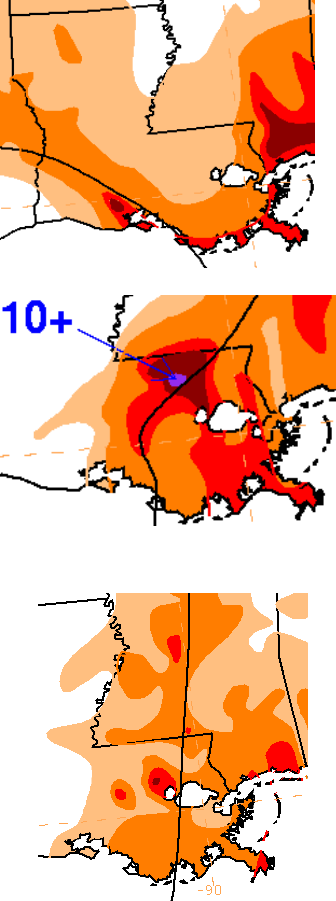
43
occurred but Edith caused no deaths across Cameron or Vermilion Parishes.
September 7-8
th
, 1974 (Carmen): Carmen moved inland just east of Vermilion Bay near
Point Au Fer after crossing the Gulf of Mexico as a major hurricane. Winds reached 110 mph at
the Bayou Boeuf oil rig near Ameila, 100 mph with gusts to 120 mph at the KROF radio station
in Abbeville, and 85 mph at Morgan City. Damage was generally confined to the sugar crop and
offshore oil installations. Piers at Marsh Island succumbed to 15 foot seas pounding the coast.
Morgan City lost its power and telephone service.
Two tornadoes were spawned on the morning of
September 8th: One in Franklin at 4 AM which destroyed a
service station, and another at Kaplan at 9 am. Tides of 4-6
feet above mean sea level went ashore along the coasts of
St. Mary, Terrebonne, Lafourche, Jefferson, and
Plaquemines Parishes. The heaviest rain fell along its track,
and well east of the center along the central Gulf coast. The
maximum amount was reported was 9.20”, which fell eight
miles south of Kaplan. Total damages from the hurricane
reached $150 million. Three deaths were indirectly
associated with Carmen.
September 5
th
, 1977 (Babe): Babe developed in the Gulf
of Mexico as a subtropical storm as it became vertically
stacked with the upper level low which caused it formation.
It moved northward into Southeast Louisiana and briefly
reached hurricane status prior to landfall. After landfall, the
storm finally took on tropical characteristics fully by gaining
central convection. Heavy rains fell east of the Vermilion
river across southeast Louisiana, with 10.70” measured at
Pine Grove Fire Tower. Wind and water damage occurred in
St. Mary, Iberia, and St. Martin parishes.
July 11
th
, 1979 (Bob): Hurricane Bob struck Terrebonne
bay on the 11
th
. It was a very well-behaved storm and was
quite predictable in track and strength. Highest storm surge
reported was 5.02 ft on the north end of the causeway bridge
across Lake Pontchartrain. The pressure fell to 29.28" at
Moisant Field, as winds gusted to 44 mph during the storm.
Heavy rains fell mainly east of the Atchafalaya swamp, with
a maximum of 7.16” recorded Springville Fire Tower. One
tornado was reported in Slidell. One person died, being
blown off his roof as he was nailing it down during the
hurricane. Damages totaled $2.3 million to property, and $1
million to the rice and sweet potato crops.

44
July 24-27
th
, 1979 (Claudette): As Bob was moving
back out into the Atlantic off the North Carolina coast, a new
tropical depression was sighted midway between Africa and
the Lesser Antilles. It briefly became a tropical storm,
named Claudette, as it approached Puerto Rico. The system
took a track which nearly dissipated the system, as it moved
across Hispaniola and Cuba before entering the Gulf of
Mexico.
As the cyclone moved towards the upper Texas coast, its
motion slowed to a crawl. This left the Pelican state to the
right of the system for two days, leading to very heavy rains.
Over a foot of rain fell across southwest Louisiana. However, Texas saw the worst of the storm
when 43 inches of rain fell at Alvin.
September 5
th
, 1980 (Danielle): A tropical depression
formed about 100 miles offshore the Mississippi Delta, and
paralleled the coast towards the west while it intensified into a
tropical storm. A small tropical cyclone, Danielle still
brought high winds and seas to the state of Louisiana. The
highest rain totals seen with the cyclone were in Hackberry
(4.91”), Baker (4.98”), and Old River Lock along the Red
river (5.09”). High winds and waves south of Grand Isle
caused a jack-up barge to collapse. Four men were thrown
into the Gulf, but only three were rescued. Some beach erosion occurred with this system. As it
moved into Texas, heavy rains ended a drought within the Lone Star state.
August 15-16
th
, 1985 (Danny): On the 12
th
, a tropical
depression formed in the northwestern Caribbean sea. As it
moved through the southern Gulf of Mexico, the cyclone
became a tropical storm, and was named Danny. Danny
strengthened into a hurricane on the 15
th
just offshore
Louisiana, before it came ashore near Pecan Island August
16
th
. In Abbeville, winds gusting to 114 mph blew off the r
of a school. High winds destroyed an airplane hangar in Iowa.
Trees were uprooted throughout southern and central
Louisiana. Thirty-nine tornadoes were spawned throughout
the Southeastern United States, most occurred as Danny
oof
tracked northeast through Alabama and Tennessee. Only three touchdowns were noted across
Louisiana.
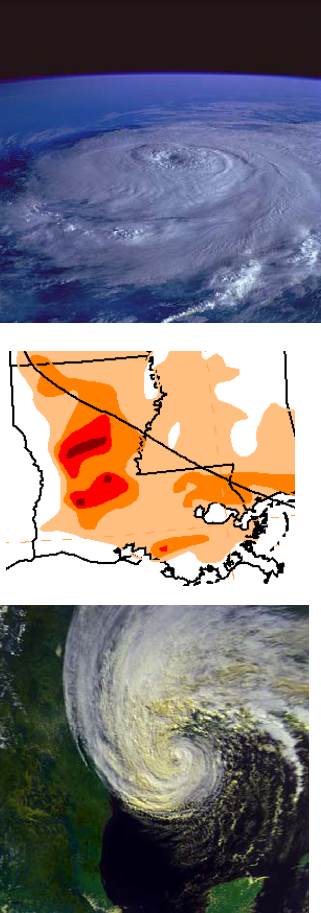
45
Storm surges of eight feet were seen along the coast of south-central Louisiana. Highway 46
near Hopedale in St. Bernard Parish was impassable due to the high waters. The pier at Grand
Isle State Park was damaged, while a pier near Slidell was demolished. Coastal erosion was
greatest in Terrebonne and lower Jefferson parishes. Heavy rains fell near and east of its track,
with the highest total of 8.91” measured at Kentwood. Seven injuries were reported, but no one
died in the storm. Six of the injuries were due to the capsizing of a 41-foot sailboat near the
Timbalier Islands. Sugar cane and soybean crops were damaged extensively. Total damages were
estimated to be near $14 million.
September 2
nd
, 1985 (Elena): Elena formed over Cuba,
and made a clockwise loop in the northeast Gulf of Mexico
just offshore Cedar Key before being steered west-
northwest to the central Gulf coast. The image to the right
was taken by the Space Shuttle just prior to landfall. The
cyclone went ashore the Mississippi coast near Biloxi as a
major hurricane and was the second of three hurricanes to
hit the state that season. Elena continued its west-northwest
track through southern Mississippi and northern Louisiana,
before recurving through Arkansas and Missouri. Even as
its surface circulation weakened, its mid-level circulation
continued producing heavy rains across the lower
Mississippi valley through the 5
th
before the system
completely dissipated.
Many chose to evacuate southeast sections, with 400,000
fleeing the state. Elena entered Washington Parish as a
category one hurricane and downed numerous trees. Heavy
rains fell primarily across central Louisiana, with a
maximum of 8.85” measured at Gorum Fire Tower.
October 27-31st, 1985 (Juan): Juan formed in the Gulf
of Mexico on October 25
th
due to the formation of an upper
level low and developed within a cool environment. This
large storm drifted northward, looping near southern
Louisiana between the 28
th
and the 30
th
while weakening
back into a tropical storm. The highest wind gust recorded
at NWS Lake Charles was 49 mph, which became the
highest recorded during the month of October since records
began in 1939. Over ten inches of rain fell across Imperial
Calcasieu as well as portions of southeastern Louisiana,
with Galliano receiving 17.78”. To the right is an image of
Juan in the Gulf of Mexico taken by the NOAA-9 polar
orbiting satellite.

46
Storm surges reached eight feet at Cocodrie. Highway
LA 1 south of Leeville and Highway LA 3090 near
Fourchon were destroyed. Three bridges were washed out
near Lacombe on LA 434. Levees were overtopped in
Lockport, Marrero, Oswego, and Myrtle Grove; this added
to the already serious flooding. Two hundred cattle were
drowned in Terrebonne Parish. Grand Isle was under four
feet of water while 1200 residents were trapped on the
barrier island.
Offshore, conditions were far worse. An oil rig 35 miles south of Leeville collapsed, then
smashed into a neighboring rig while in 20 foot seas and hurricane force winds late on the 27
th
.
The ship Miss Agnes sank during a rescue operation 60 miles south of Morgan City that day. The
rig AM Howard capsized early on the 29
th
. The boat Kiwi sank while in the Atchafalaya Bay.
This all led to nine lives being lost offshore. Total damages exceeded $300 million and 12 people
died in all. Damages from Danny, Elena, and Juan across Louisiana totaled $2.5 billion and 19
people perished.
June 26
th
, 1986 (Bonnie): Bonnie, a minimal hurricane,
moved ashore just southwest of Sabine Pass on the 26
th
, then
moved northward through East Texas before recurving
northeast into Arkansas on the 27
th
. Some beach property
was damaged in Cameron Parish with water damaging
coastal roadways in Western Cameron Parish. Five tornadoes
were caused by Bonnie in Louisiana; three in DeSoto and
Webster Parishes alone, located in the northern section of the
state.
At 2 AM CST on the 27
th
, a period of 10-14 hours of
heavy rain fell in Northwest Louisiana in Caddo, Bossier,
and Northern DeSoto Parishes, causing extensive flash flooding between 5 and 9 AM CST. The
highest rainfall total was 9.92” measured one mile north of Mooringsport. Interstate highway 20
was under 5 feet of water. Highways US 71 and LA 1 were cut by flash flooding. Flooding alone
caused $10 million in damages. Only one person died in the storm, when winds overturned his
fishing boat in Cross Lake.
September 9
th
, 1988 (Florence): A coastal trough developed over the Western Gulf of
Mexico on September 1
st
at the tail end of an old frontal zone. It moved into Southeast Louisiana
on the 4
th
, but began drifting south again as a strong high pressure system dived south out of
Canada. On the 6
th
, it had moved southwest into the Western Gulf of Mexico before drifting back
to the east on the 7
th
. It finally developed enough tropical characteristics to be designated a
tropical storm, and moved north toward Louisiana.

47
It rapidly strengthened and became a hurricane before striking
Port Eads on the 9
th
. However, the system had begun weakening as
dry air began to intrude into the western portion of the circulation.
It became extratropical by the 11
th
, as dry air continued to wrap
around the western semicircle. The low dissipated later that day, as
it drifted northwest over Oklahoma.
Highest winds reported were at New Orleans Lakefront Airport,
which received a gust to 61 mph. Lowest pressure noted inland
was 29.26" at New Orleans Naval Air Station. Highest rain total
with the system was 4.47" at Abita Springs Fire Tower.
Significant beach erosion occurred along Grand Isle. Trees were downed, mostly in Orleans
Parish. The storm surge flooded LA 300 near Delacroix. Total damages were estimated near $2.5
million.
August 26
th
, 1992 (Andrew): Andrew formed in the
tropical north Atlantic, and remained a tropical storm as
it tracked northeast of the Leeward Islands. After
escaping an environment of vertical wind shear, Andrew
strengthened markedly north of the Greater Antialles,
becoming a category five hurricane which slammed into
South Florida on August 24
th
before striking the
Louisiana coastline on the 26
th
.
Seven people died and 94 were injured across Southern Louisiana during Andrew. Winds
reached hurricane force from Lafayette eastward to the Atchafalaya. The highest gusts reported
were: 39 mph at Lake Charles Regional Airport, 66 mph at Moisant International Airport in New
Orleans, 71 mph at Lafayette Regional Airport, 83 mph at Salt Point in St. Mary Parish, 104 mph
at the Lafayette Parish Courthouse, 153 mph at the New Iberia Emergency Operating Center, and
173 mph at the Drilling Barge on Bayou Teche in St. Mary Parish.
Rainfall totals from Andrew exceeded 5 inches over a
four day period from August 24-28 in many
locations...with Robert receiving 11.02" and Hammond
receiving 11.92". The storm surge moved inland from
Lake Borgne westward to the Vermilion Bay...the highest
surge reported was at 6.48 feet at Bayou Dupre. An F3
tornado struck LaPlace and stayed on the ground until
reaching Reserve in St. John the Baptist Parish which
caused 2 of the deaths. Around 1 1/2 million people
evacuated across Southern Louisiana with damages
estimated near 1 billion dollars in Louisiana.

48
October 4
th
, 1995 (Opal): Opal, after moving
aimlessly in the Bay of Campeche for days at the
beginning of October, moved northeastward, passing
150 miles off the Mississippi Delta towards the Florida
panhandle on the morning of the 4
th
. Rainfall amounts
were greater than two inches across Southeast
Louisiana. Winds in extreme Plaquemines Parish were
near 60 mph with gusts to hurricane force. To the right
is an infrared satellite picture of Opal, taken on the 4
th
by GOES-8.
Damage occurred to area roofs and also to some mobile homes. Gale force winds were seen in
Southern Lafourche, Jefferson, and East St. Bernard Parishes. Storm surges were 3 to 5 feet
from Grand Isle eastward. Significant damage occurred across the barrier islands of Southeast
Louisiana. Ten thousand people evacuated the region. One person was injured when the large
flag he was lowering became a parasail, tossing him high into the air and causing significant
injuries.
October 5-8
th
, 1996 (Josephine): A gale center in the Western Gulf of Mexico that became
Josephine teamed up with a strong high pressure ridge over the Southeast United States. This
caused strong east to northeast winds, inducing tides to 4 feet above normal along the entire
Louisiana coast. The highest tide noted was 5.5 feet at Bayou Bienvenue, near Lake Borgne.
Highway 1 was under a foot of water. A few homes and roads were also flooded in Orleans and
St. Bernard Parishes, outside the flood control levees. Damages totaled $5.5 million.
July 17-18
th
, 1997 (Danny): A cluster of showers
and thunderstorms moved off the Louisiana coast on
July 13th, leaving strong winds and damage in its wake
in Southern Louisiana. A low level circulation became
apparent south of Houma early on the afternoon of the
14th and drifted slowly southwest. By the 16th, the low
had stalled near 27N 92W...about 150 miles offshore.
By late in the day, the system had developed into a
tropical depression. Early on the 17
th
, the center jumped
about 80 miles to the east-northeast and the system
began to intensify rapidly.
Danny had formed that morning and became a hurricane by the next day as it slowly moved
east-northeast. Winds gusted to 95 mph at Grand Isle, just as the center made a brief landfall on
the morning of the 18th, before progressing over to Mobile to cause copious amounts of rain in
the vicinity of Dauphin Island as the system stalled again late on the 19th through early on the
21st.
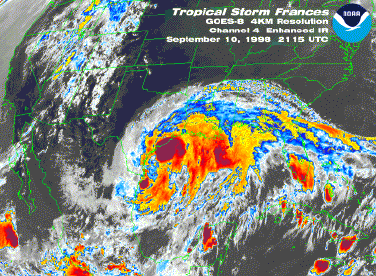
49
Danny then moved northward to Western Alabama before making a hard right, moving across
Atlanta and Raleigh-Durham. As it moved across North Carolina, it became a tropical storm
again and moved northeast off the lower Virginia coast on the morning of the 24
th
, becoming an
extratropical storm just off Nantucket the next evening.
The storm surge measured 5.4 feet at Grand Isle, which caused significant flooding to the
island along with moderate to severe beach erosion. Rain totaled 11.40" at Buras, where 170
boats sustained damage. Much heavier rains were saved for southern Alabama, where Danny
stalled after it passed by the Bayou State. Ninety-one businesses and 173 houses experienced
damage in Plaquemine and Jefferson Parishes.
September 10-14
th
, 1998 (Frances): On the 7
th
, an
area of disturbed weather formed in the Central Gulf of
Mexico. It was complex with a broad area of low
pressure, induced by a nearby upper low to the west of
the circulation. Strong easterly winds had barely relaxed
after Charley, which had just made landfall in Texas,
before redeveloping. Air Force aircraft investigated the
system on the 8
th
, and a tropical depression was found
220 miles southeast of Corpus Christi. It moved very
little over the next 24 hours, slowly strengthening into a
tropical storm by the 9
th
. Strong winds along the
Louisiana and Texas coasts increased, resulting in a large area of coastal flooding. Sabine Pass
was cut off to travel by land on the 10
th
and remained so for the next week, until Hermine passed
by to the east.
Frances began to move north on the 10
th
, and the drought-ending rains began. A large area of
tropical storm force winds buffeted the coasts of Louisiana and Texas, worsening the coastal
flooding and leading to backwater flooding of area rivers, as water was no longer able to drain
into the Gulf of Mexico. Meacom's pier was nearly destroyed. San Luis Pass pier was damaged.
Grand Isle went underwater, but water never reached the homes as they were on pilings rising up
from the island. Tides ran as high as 5.4 feet at Cameron and Sabine Pass. Five homes in
Constance Beach fell into the Gulf, while sand piles up on Holly Beach. Offshore oil platforms
saw howling winds reaching as high as 90 mph in gusts.

50
The system strengthened and moved north as feeder bands
moved inland, increasing the rainfall across the region. The
deluge caused a large area of 10 inches of rain or more across
southern Louisiana and eastern Texas. The highest rain totals
noted were 21.10" at Terrytown in Southeast Louisiana and
14.62" at the Lacassine Wildlife Refuge, ten miles south of
Lake Arthur. The pressure induced by all the rain in New
Orleans caused manholes to be blown skyward. Sections of I-
10 in New Orleans and Houston were underwater on the
11th. Roads and bridges were submerged near Corpus
Christi. Numerous towns evacuated in the face of flash
flooding.
The center made landfall at midnight on the night of the 10
th
near Matagorda, Texas and
became stationary again on the 11
th
, prolonging the wind and rain. During the 12
th
, the system
resumed its northerly course through East Texas before accelerating into Iowa on the 14
th
. Rains
of five inches or more soaked Mississippi, Oklahoma, Arkansas, Kansas, and Missouri.
At least 8 tornadoes touched down across the state on the 11
th
and 12
th
. Seven tornadoes
wreaked havoc across South Central Louisiana near Lake Arthur, Estherwood, Basile, Oberlin,
and Lafayette. A Lafourche parish man was killed when a tornado destroyed his mobile home.
The coastal flooding and beach erosion were the worst seen since Carla (1961). River
flooding was significant across East Texas and Louisiana. A major disaster declaration was
issued for Cameron, Jefferson, Lafourche, and Terrebonne parishes. Over $10 million in damage
was experienced across Southwest Louisiana and Extreme Southeast Texas.
September 27-28
th
, 1998 (Georges): In mid-September, a
tropical storm formed in the East Atlantic. It moved west-
northwest and became a major hurricane as it approached the
Lesser Antilles. Georges left a trail of destruction as it raked
the Virgin Islands and most of the islands of the Greater
Antilles. Over $2 billion in damages occurred as Georges
terrorized the West Indies. The hurricane struck the
Mississippi coast at Category 2 intensity. Winds gusted to 55
mph at New Orleans Lakefront
Airport...the pressure fell to 29.37”.
Storm surges above seven feet overflowed some of the land surrounding Lakes Pontchartrain
and Borgne...a storm surge of 8.9 feet was noted at Northeast Gardene Bay, east of Pointe a la
Hache. A large number of fishing camps were damaged or destroyed along Lake Pontchartrain.
Two died from Georges in Louisiana.
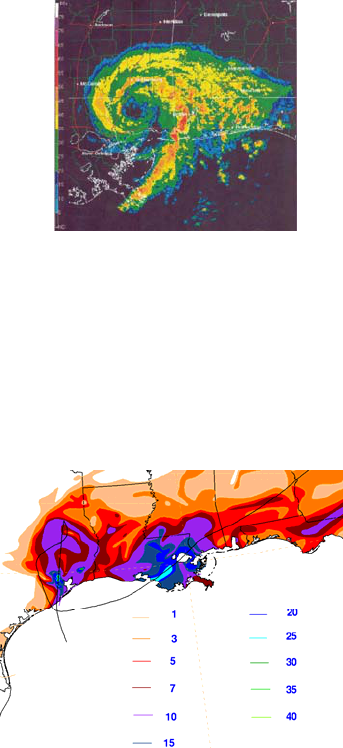
51
Early Twenty-First Century Hurricanes
June 4-11
th
, 2001 (Allison): A tropical wave moved off
the west coast of Africa on May 21st. Tracking westward, it
moved through the tropical Atlantic and Caribbean
Sea...reaching the eastern Pacific Ocean on June 1st. A low
level circulation formed on the 3
rd
south of Vera Cruz, and
this system moved north into southeast Mexico steered by
deep southwest flow. It emerged into the Bay of Campeche on
the 4
th
as an area of thunderstorms, and guided north-
northwest through the western Gulf of Mexico.
The low became increasingly organized, and became a tropical storm about 80 miles south of
Galveston Texas. Steered by the subtropical ridge off the southeast, Allison moved north into
Texas that evening, eventually tracking as far inland as Lufkin by the morning of the 7th. After
already dropping ten or more inches of rain across portions of Texas and Louisiana, the cyclone
began to move southward as a ridge over New Mexico strengthened just as the high off the
southeast flattened and moved southeast.
This set the stage for massive flooding in southeast
Texas on on the 7
th
and 8
th
. The highest totals noted were
40.68 inches at Moore Road Detention Pond in Jefferson
County, Texas, with 36.99 inches at the Port of Houston
Texas, and 29.86 inches at Thibodaux Louisiana. Portions
of Houston, Beaumont, Thibodaux, Lafayette, New Orleans,
and Baton Rouge saw severe flooding from this excessive
rainfall. Rains would continue into the 11
th
, as Allison
moved back off the Texas coast, paralleling the coast of
Louisiana before making a second landfall in the Teche
region of the Bayou State.
Reintensifying over land as it tracked through southeast Louisiana and southwest Mississippi,
Allison formed an eye feature during the morning of the 11
th
, a rare accomplishment for a
tropical cyclone over land. The system moved swiftly east-northeast crossing southern
Mississippi and Alabama, central Georgia, and South Carolina, being steered by the subtropical
jet stream to its north. Allison would continue moving northward along the East coast through
the 16
th
. One person died due to the storm as a tornado in Zachary knocked a tree onto his truck.

52
September 23-27
th
, 2002 (Isidore): A tropical wave
moved off the coast of Africa on September 9
th
accompanied by a large area of thunderstorms. The
convective activity decreased significantly as the system
moved toward the west-southwest during the next few days.
As the wave approached the 50
th
meridian longitude, the
shower activity began to increase and an upper-level
anticyclone became evident over the system. Shortly after
noon on the 14
th
, the system became a tropical depression as
it approached Trinidad. As it moved west-northwestward
and interacted with the South American landmass, it
weakened back into tropical wave in the eastern Caribbean
Sea. As the tropical wave emerged into western Caribbean
Sea, it redeveloped a closed circulation and regained
tropical depression status on the morning of the 17
th
.
Strengthening into a tropical storm after midnight on the
18
th
,
the tropical cyclone moved very slowly toward the northwest, passing just west of Jamaica.
Isidore then moved very slowly toward the west-northwest across the Cayman Islands and
strengthened, as it became a hurricane shortly after noon on the 19
th
Isidore reached its peak
intensity of 125 mph after noon on the 21
st
.
Isidore meandered for 24 to 36 hours over northern Yucatan and weakened to a minimal tropical
storm. It moved northward over the Gulf of Mexico where the circulation expanded but the
cyclone never redeveloped an inner core of strong winds due to its extremely warm, and stable,
core. Isidore regained central convection as it made landfall with winds of 65 mph just west of
Grand Isle, Louisiana just after midnight on the 26
th
. Once it moved inland, Isidore
weakened to a tropical depression and moved north-northeastward across the southeastern
United States, producing torrential rains. It became an extratropical storm over southwestern
Pennsylvania during the early afternoon of the 27
th
, and was then absorbed into a frontal zone.
One died at Port Fourchon due to rip currents in advance of Isidore. Damaged totaled $330
million, mostly within Louisiana.
October 2-5
th
, 2002 (Lili): Lili originated from a tropical wave that moved over the tropical
Atlantic Ocean from the west coast of Africa on September 16
th
. The wave developed a low -
level cloud circulation center midway between Africa and the Lesser Antilles on the 20
th
and
eventually into a tropical depression on the 21
st
about 900 n mi east of the Windward Islands.
Tracking around the southwestern periphery of the subtropical ridge, the system moved just
north of due westward at near 25 mph, crossed the Windward Islands as a developing tropical
storm on the 23
rd
and then its winds briefly reached 70 mph on the 24
th
. The storm weakened to
an open tropical wave on the 25th and 26th in the east central Caribbean Sea as its organization
was disrupted by vertical wind shear. Lili re-acquired a low-level closed circulation on the 27
th

53
when its forward speed slowed towards 6 mph by the 28
th
while beginning a slow northward jog
around the north coast of Jamaica. The storm dumped heavy rain on Jamaica and also Haiti.
Resuming a west-northwestward track, Lili became a hurricane
on the 30
th
, while passing over Cayman Brac and Little Cayman
Islands. The center of the hurricane moved over the southwest tip
of the Isle of Youth on the morning of October 1
st
, and over
western mainland Cuba a few hours later, with wind speeds as
high as 105 mph.
Gradually accelerating its forward speed towards 18 mph, Lili
turned northward and made landfall on the Louisiana coast on the
3rd, with an estimated 90 mph maximum wind speed after rapidly
weakening during the 13 hours prior to landfall. Lili was absorbed
by an extratropical low on the 4
th
while moving northeastward near
the Tennessee/Arkansas border. Sugar cane fields were flattened
across southern portions of the state. Damages totaled $830
million within the state. One person died due to carbon monoxide poisoning in Crowley due to
the running of a generator.
October 6-12, 2004 (Matthew): The origin of Matthew can be
traced to a tropical wave that moved across the west coast of Africa
on September 19
th
, moving closely to Tropical Storm Lisa and
another large disturbance in the tropical Atlantic. The wave crossed
the Lesser Antilles on the 29
th
and interacted with a westward
moving upper-level low. Cloudiness and showers increased as the
wave moved very slowly westward, trailing the upper-level low.
The shower activity associated with the wave reached the Bay of
Campeche on October 5
th
and gradually became better organized
while moving little. An upper-level ridge became established over
the convection leading to falling pressures in the area.
On the 7
th
, a broad area of low pressure had formed just east of Tampico, Mexico. The
system continued to become better organized while moving little and became a tropical
depression on the morning of the 8
th
about 180 n mi southeast of Brownsville Texas. By that
afternoon, the cyclone strengthened into Tropical Storm Matthew. Initially, the cyclone moved
toward the east and east-northeast, but then gradually turned to the northeast and north steered by
a large mid- to upper-level low over western Texas. Matthew reached its peak intensity of 45
mph and a minimum pressure of 997 mb early in the afternoon of the 9
th
. Matthew's center made
landfall just west of Cocodrie, Louisiana early in the morning on the 10
th
as a minimal tropical
storm. Thereafter, Matthew weakened to a depression before crossing the upper jet and
becoming an occluded cyclone. It continued moving northeastward across the Mid-Mississippi
and lower Ohio valleys before becoming absorbed by a frontal wave in the Great Lakes on the
morning of the 14
th
. A tornado touched down near Golden Meadow, which damaged the roof of
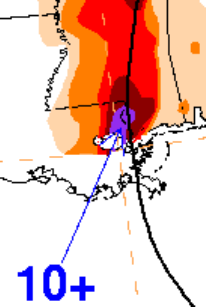
54
a trailer. Extensive beach erosion occurred at Grand Isle, as the storm surge reached 5.85 feet at
Frenier.
August 29
th
, 2005 (Katrina): This horrific storm formed from a tropical wave...becoming a
depression about 175 miles southeast of Nassau in the Bahamas on August 23
rd
. It developed
into a tropical storm on the 24
th
. Katrina moved northwestward through the Bahamas...and then
turned west-southwest into South Florida before turning sharply south-southwest through
Miami/Dade county as a minor hurricane, dumping heavy rainfall to the left of the track, and
high winds to southeast Florida and the Florida Keys.
As the system emerged into the Gulf of Mexico the storm strengthened, reaching category
five status on the 28
th
about 250 miles south-southeast of Burrwood, Louisiana. Its central
pressure fell to 902 mb...the fourth lowest on record for the Atlantic Basin and lowest inside the
Gulf of Mexico...later that day. Katrina slowly recurved...moving through lower Plaquemines
Parish south of Buras with 140 mph winds at 6:10 AM on the 29th. Katrina made a second
landfall near the mouth of the Pearl River at 10:00 AM...with maximum sustained winds near
125 mph.
Katrina weakened as it moved inland to the north-northeast but was still a hurricane 100 miles
inland near Laurel, Mississippi. Katrina continued to weaken and became a tropical depression
near Clarksville, Tennessee on the 30th. Katrina accelerated
east-northeastward and was absorbed into a developing
extratropical cyclone to its northeast as it reached central
Pennsylvania. The lowest pressure recorded was 27.17” at
Buras. The highest wind gust was estimated at 123 mph at the
NASA Michoud Assembly Facility. The maximum rainfall
recorded within Louisiana was 14.82” at Big Branch.
Katrina will likely be recorded as the worst natural disaster in
the history of the United States...producing catastrophic damage
and untold casualties in the New Orleans area and along the
Mississippi Gulf Coast. As of August 10, 2006, the death toll was designated as 1577 within the
borders of the Pelican state. Damages totaled $81 billion within the United States.
September 23-25
th
, 2005 (Rita): Rita was an intense, destructive, and deadly hurricane that
devastated extreme southeast Texas and southwest Louisiana. It formed off an old frontal zone,
and developed into a tropical depression on the 17
th
just east of the Turks and Caicos Islands and
moved westward, becoming a tropical storm on the afternoon on the 18
th
and a hurricane on the
20
th
as it moved through the Florida Straits. The center of Rita passed just south of Key West
before it emerged into the Gulf of Mexico and rapidly intensified. Maximum sustained winds
increased to 175 mph on the 22
nd
while moving through the central Gulf of Mexico, and its
pressure fell to 897 hPa, the 3
rd
lowest on record for the Atlantic Basin and the lowest reported
from the open waters of the Gulf of Mexico.

55
Easterly gales into Lake Ponchartrain led to renewed flooding
in the Ninth Ward of New Orleans. A significant shearline aloft
lured Rita more northwesterly, and the storm weakened as it
moved away from the warm waters of the loop current. Landfall
occurred at 2:30 AM between Sabine Pass and Johnsons Bayou,
LA while a category three hurricane. Rita slowly weakened as it
accelerated inland, and maintained at least tropical storm
strength when it crossed back into northwest Louisiana. The
cyclone moved northeast and merged with a frontal wave on the
26
th
.
Heavy rains fell near and east of the track of the hurricane, with the highest total in Louisiana
recorded at Bunkie, where 16 inches fell. A C-MAN station along the Sabine River recorded a
gust of 99 mph. The lowest pressure recorded within Louisiana was . A storm surge of 15 feet
was recorded at Cameron, with Gulf waters invading Calcasieu lake, which subsequently caused
an eight foot storm surge at Grand Lake. The storm surge moved up the Calcasieu river as far as
the Interstate 10 bridge in Lake Charles. Waters as deep as 6 feet submerged portions of
downtown Lake Charles. Most, or all, of Vermillion, Iberia, and St. Mary parishes south of
Louisiana highway 14 and U.S. highway 90 were submerged. The towns of Holly Beach,
Cameron, Creole, Grand Chenier, and Pecan Island were nearly completely destroyed. A storm
surge of 4-7 feet inundated southeast Louisiana as well. Ninety tornadoes were spawned by the
hurricane across Alabama, Mississippi, Louisiana, and Arkansas. One died in Louisiana from
Rita. Damages from the cyclone totaled $10 billion.
September 13-14
th
, 2007 (Humberto): A broad low pressure area formed along a surface
trough in the western Gulf of Mexico. An area of thunderstorms formed on the northern end of
the trough, which forced the develoPMent of a new, well-defined low pressure area. The system
organized into a tropical depression on the morning of the 12
th
. Rapid develoPMent ensued, and
within 18 hours of becoming a tropical depression Humberto became a tropical storm and then a
hurricane as it headed north-northeast into the Golden Triangle of Southeast Texas during the
early morning hours of the 13
th
, becoming the most rapidly developing tropical cyclone known to
develop close to land in the Atlantic Basin. Weakening slowly after landfall, Humberto regained
tropical storm and then tropical depression status as it moved through Louisiana into
Mississippi. Its surface circulation was left behind across Louisiana as west-southwest vertical
wind shear carried its mid-level center northeastward.

56
According to surface analyses and satellite imagery, as
Humberto's mid-level circulation continued progressing northeast,
it spawned a new low pressure area in Georgia which forced the
original circulation southeast towards northern Florida before
dissipation. As the mid-level center continued progressing, a third
cyclone in southeast Virginia developed and moved northeast into
the western Atlantic, absorbing the second low. A total of 13,000
lost power statewide during Humberto’s passage. Overall property
damage was estimated at $50 million across Texas and Louisiana.
August 31-September 3
rd
, 2008 (Gustav): A tropical wave moved across the tropical North
Atlantic ocean. It brought squally weather to the Windward Islands before entering the
Caribbean Sea. The system developed due to favorable upper level conditions, and became
Tropical Depression Seven by August 25
th
, and a tropical storm later that day. While
approaching Hispaniola, strengthening continued and Gustav reached hurricane strength early on
the 26
th
. The cyclone moved across southwest Haiti before dropping southwest towards Jamaica
due to strengthening high pressure to its north and northwest. The system, then a tropical storm,
nearly reached hurricane strength before moving near Jamaica.
Clearing the island, Gustav regained hurricane strength and rapidly intensified into a category
four hurricane which struck western Cuba on the 30
th
. A combination of land interaction with
western Cuba and an upper level low to its west kept Gustav on a slow weakening trend until its
final landfall in southeast Louisiana on September 1
st
. The system slowed to a crawl across
northwest Louisiana and southwest Arkansas on the 2
nd
and 3
rd
, dropping heavy rainfall across
east-central Louisiana, Arkansas, and southwest Mississippi.
Heavy rains fell along and east of its track within east-
central and south-central Louisiana and western Mississippi,
with the highest total measured of 21 inches at Larto Lake.
Winds gusted to 117 mph at Southwest Pass. The lowest
reliable pressure observed was 28.15” at Caillou Lake.
Eleven tornadoes touched down within the state borders. A
storm surge of 12-13 feet swamped the Mississippi Delta, and
and 9-10 foot surge in southeast Louisiana overtopped some
flood walls and levees in New Orleans, though flooding due
to surge in New Orleans was not widespread. Seven perished
from Gustav in Louisiana.
September 12-14
th
, 2008 (Ike): A tropical wave left the coast of Africa on August 28
th
. The
system slowly organized, becoming a tropical depression, then a tropical storm, on September
1
st
. The cyclone moved westward for much of its lifetime as the subtropical ridge extended
westward to its north. By the 3
rd
, Ike had become a hurricane, then a major hurricane as it
rapidly intensified underneath an upper level high. Ike wavered between category two and four
strength due to northerly vertical wind shear and eyewall replacement cycles. On the 7
th
, Ike

57
moved through the southeast Bahamas into eastern Cuba. Briefly emerging into the northwest
Caribbean, Ike remained a hurricane through its next landfall across western Cuba on the 9
th
.
Land interaction appears to have made Ike a larger cyclone after interacting with western Cuba,
and its central pressure fell significantly on the 10
th
as it moved over the Loop Current. The
large system strengthened back into a category 2 hurricane, which moved west-northwest
through the Gulf of Mexico around the periphery of the subtropical ridge.
On the 12
th
, Ike became slightly more compact as it moved
into a confluent zone between the subtropical ridge to its east-
northeast and troughing across the Plains. This allowed
maximum sustained winds to increase despite a relatively
constant central pressure. Ike developed a banding-type eye,
and moved into Galveston, Texas, and weakened as it moved
into through eastern Texas and Arkansas. Heavy rains were
confined to its track, and amount were limited under five
inches across Louisiana. The main effect from Ike was storm
surge. Across southeast Louisiana, the surge was limited to 3-
6 feet. Surge heights increased significantly west of Grand Isle, reaching 17 feet at Cameron,
which overspread the parish. Two died in Louisiana and overall damaged reached $19.3 billion.
Acknowledgments
During the initial three year journey in preparing this Louisiana Hurricane History in the
late 1990’s, many people helped along the way. The base framework for the document was a
one page public information statement sent out annually from the New Orleans office during the
mid 1990’s which was subsequently expanded. Roger Erickson, WCM at Lake Charles, helped
in locating some of the material locally for this work while I was stationed at the Lake Charles,
Louisiana forecast office. A great deal of support was given by management on this endeavor:
the list includes Ellie Pittman (former Data Acquisition Program Manager (DAPM) at Lake
Charles), Steve Rinard (former Meteorologist in Charge at Lake Charles), and Rick Gravitt
(current DAPM at Lake Charles). Photographs taken during Danny, Frances, and Georges are
used with the permission of A. J. Sisco, their photographer.
A significant amount of research was acquired from other sources. All tracks from 1886
onward were provided in the database done by Neumann, et al, and maintained by the National
Hurricane Center in West Miami, and generated using nMAP software at the
Hydrometeorological Prediction Center (HPC) in Camp Springs, MD. Information from the
metadata regarding changes to the tropical cyclone database at the Hurricane Research Division
was used for a few storms in the late nineteenth century. Some United States Signal Corp and
Army Surgeon records were obtained from the Library of Congress concerning a few of the
systems in the 19
th
century. The Washingtonian Division of the Martin Luther King library in
Washington, D.C. was utilized for searching newspaper records on microfilm for the 1812

58
hurricane. Rainfall graphics used in this document were constructed by the author while
developing a tropical cyclone rainfall database between 1999 and 2010, using data primarily
supplied by the National Climatic Data Center in Asheville, North Carolina for the United States.
Most of the satellite imagery used was provided by the National Climatic Data Center in
Asheville, North Carolina. Many visits to McNeese State University in Lake Charles, LA and
Louisiana State University in Baton Rouge provided a volume of newspaper articles, along with
unique pieces from their respective archives.
Work was coordinated with John Guiney (formerly at the Slidell office) and Henry Diaz at the
Climate Diagnostics Center in Boulder, Colorado. Posthumously, David Ludlum, Ivan Ray
Tannehill, Gordon Dunn, Jose Fernandez-Partagas, and David Cipra are to be honored; without
them much of the information on storms before 1871 could have been lost to history.
Bibliography
Addison, E.L.: "Little Drops of Water" Meridional 6 September 1879: Abbeville, 2.
_____: "The Equinoctial Blow" Meridional 13 September 1879: Abbeville, 2.
_____: Meridional 20 September 1879: Abbeville, 2.
_____: Meridional 23 September 1882: Abbeville, 2.
_____: Meridional 26 June 1886: Abbeville, 1.
_____: Meridional 27 October 1887: Abbeville, 2-3.
_____: "A New State Weather Service" Meridional 29 October 1887: Abbeville, 1.
_____: Meridional 25 August 1888: Abbeville, 2-3.
_____: Meridional
1 September 1888: Abbeville, 3.
_____: Meridional 16 September 1893: Abbeville, 2.
_____: "The October Hurricane" Meridional 7 October 1893: Abbeville, 2-3.
_____: "Sunday's Storm" Meridional 18 September 1897: Abbeville, 3.
_____: "Cheniere au Tigre" Meridional 18 September 1897: Abbeville, 3.
_____: "We Missed the Storm" Meridional
15 September 1900: Abbeville, 3.
Armstrong, Gladys. “The Great 1893 Hurricane” Deep Delta Quarterly Volumes 1-2.

59
Plaquemines Parish Geneology Society: Buras, 1984.
Associated Press: “Danger Tropical Disturbance Passed, Says Washington” Daily American-
Press 22 September 1920: Lake Charles, 1-2.
_____: “Warnings for Small Craft are Still Displayed” Daily American-Press 17 October 1920:
Lake Charles, 1.
_____: “Steamer Terrebone Sank in Mississippi” Daily American-Press
26 August 1926:
Lake Charles, 1.
_____: “Hurricane Velocity” Daily American-Press
26 August 1926: Lake Charles, 4.
_____: “South Louisiana Begins Rebuilding Today” Daily American-Press 27 August 1926:
Lake Charles, 1.
_____: “Aid Marooned Families” Daily American-Press 27 July 1933: Lake Charles, 1.
_____: “75 Mile Wind Hits Morgan City, Trees Strewn in Streets” Daily American-Press
16 June 1934: Lake Charles, 1.
_____: “Heavy Damage Done as Gale Sweeps Inland” Daily American-Press 16 June 1934:
Lake Charles, 1.
_____: “Seven Dead in Storm Which Swept Through Southeast Louisiana” Daily American-
Press 18 June 1934: Lake Charles, 1.
_____: “Hurricane Roars Past Terrebonne” Lake Charles American Press
6 August 1940: 1.
_____: “Cameron Area Hit By 70-Mile Wind” Lake Charles American Press 7 August 1940: 1.
_____: “Sugar Cane Crop Badly Damaged in Houma Area” Lake Charles American Press 8
August 1940: 2.
_____: “Weak Gulf Storm hits Grand Isle” Lake Charles American Press 22 August 1947: 1.
_____: “Hurricane Hits Baton Rouge” Lake Charles American Press
19 September 1947: 1.
_____: “Floods Threaten New Orleans” Lake Charles American Press
20 September 1947: 1.
_____: “Storm Whips Lake Waters Into New Orleans” Lake Charles American Press 24
September 1956: 1.

60
_____: “Flossy Heads Into Atlantic; 13 Are Dead” Lake Charles American Press 26
September 1956: 1.
Bailey, William B.: Lafayette Advertiser 30 August 1879: 2.
_____: "The Storm" Lafayette Advertiser 6 September 1879: 2.
Barnes, Jay. Florida’s Hurricane History. University of North Carolina Press: Chapel Hill,
1998.
Barry, John M. Rising Tide: The Great Mississippi Flood of 1927 and How it Changed America.
Simon and Schuster, 1997.
Beatty, Guy: “Storm Warnings Continued Today” Daily American-Press 12 September 1919:
Lake Charles, 1-2.
_____: “Location of the Storm Was Still Undetermined at 4” Daily American-Press 13
September 1919: Lake Charles, 1.
_____: “Fisherman Warned to Leave Village Along Gulf Coast” Daily American-Press 25
August 1926: Lake Charles, 1.
_____: “Flood Halts Rail, Bus Traffic North of Lake Charles” Daily American-Press 25
July 1933: Lake Charles, 1.
_____: City is Buffeted; Cameron Safe” Lake Charles American Press 15 August 1938: 1.
_____: “High Water Halts O.S.T. Traffic” Lake Charles American Press
16 August 1938: 1.
_____: “Fire Razes $50,000 Oil Office at Iowa” Lake Charles American Press 8 August 1940:
1.
_____: “Flood Waters Are Scheduled To Drop Today” Lake Charles American Press
9 August
1940: 1.
_____: “Johnson’s Bayou Is Damaged By Storm; Derricks Blown Down” Lake Charles
Press
10 August 1940: 1.
_____: “Storm Situation in Cameron No Longer Serious” Lake Charles American Press
24
September 1941, 1.

61
_____: “Rice Damaged, Highways Closed By Wind, Tides” Lake Charles American Press 24
September 1941, 1.
Benoit, George Ann. Leaves From the Diary of Louise: A Glimpse of the Social Life of Lake
Charles, Louisiana 1859-1900. Lake Charles, 1977.
Block, W. T.: “October 12 1886: The Night that Johnson’s Bayou Died” Beaumont Enterprise
10 October 1979.
_____. “Texas Hurricanes of the 19
th
Century: Killer Storms Devastated Coastline” Beaumont
Enterprise 19 February 1978, 3.
Bradshaw. "History of Acadiana" World Wide Web.
Cate, Michael. Port Arthur Centennial History: 1898-1998. Looking Glass Media: Port Arthur:
1997.
Chipman, Donald E. Spanish Texas 1519-1821. University of Texas Press: Austin, 1992.
Cipra, David L.: Lighthouses, Lightships, and the Gulf of Mexico. Cypress Communications:
Alexandria, 1997.
Cline, Isaac M. “The Tropical Cyclone of June 16, 1934 in Louisiana” Monthly Weather
Review July 1934: Washington, 249-250.
_____. Storms, Floods, and Sunshine. Pelican Publishing Company: Gretna, 2000.
De Wire, Elinor. Guardians of the Lights: Stories of the U.S. Lighthouse Keepers. Pineapple
Press, Inc.: Sarasota, 1995.
Debusschere, K. D., Lindstedt, I. A., Mendelssohn, Q. Tao, Q. Lin, 1994: Recovery of a Deltaic
Barrier Island From Hurricane and Oil Spill Impacts in Coastal Louisiana. OCS Study MMS
94-0055. Department of the Interior, Minerals Management Service, Gulf of Mexico OCS
Region, New Orleans, 82 pp.
Decker, Bill: "Some of the More Distinctive Hurricanes to Hit Louisiana" Lafayette Daily
Advertiser 31 May 1998: 6A.
Dunn, Gordon E., Banner I. Miller: Atlantic Hurricanes. Louisiana State University Press:

62
Baton Rouge, 1964. Revised edition.
Dunn, Gordon E.: "The Hurricane Season of 1960" Monthly Weather Review March 1961:
Rockville, 99-108.
_____: "The Hurricane Season of 1961" Monthly Weather Review March 1962: Rockville,
107-119.
_____, and Staff: "The Hurricane Season of 1964" Monthly Weather Review March 1965:
Rockville, 175-187.
_____, Banner I. Miller: Atlantic Hurricanes. Louisiana State University Press: Baton
Rouge, 1964. Revised edition.
Dyke, R. A. “Excessive Rainfall of July 22-25, 1933, in Louisiana and Extreme Eastern Texas”
Monthly Weather Review July 1933: Washington, 202-203.
Ellis, Michael J. 1984 Hurricane Almanac. Disaster Resources: Corpus Christi, 1984: 21-46.
Environmental Science Services Administration. September 1965 Storm Data. Environmental
Data Service: Asheville, 1965.
_____: August 1969 Storm Data. Environmental Data Service: Asheville, 1969.
Fernandez-Partagas, Jose, Henry Diaz, 1996: A Historically Significant Revision of Atlantic
Tropical Cyclone Frequency 1851 to 1890: Final Report Supplement, ERL-NOAA Report 40
RANR 503516, 62 pp.
Gales, Jr., Joseph. “Dreadful Hurricane” National Intelligencer 22 September 1812:
Washington, 2.
_____. “Awful and Distressing” National Intelligencer
26 September 1812: Washington, 2.
_____. “New Orleans, Sept. 1” National Intelligencer
1 October 1812: Washington, 3.
Gomez, Gay M. A Wetland Biography: Seasons on Louisian
a’s Chenier Plain. University of
Texas Press: Austin, 1998.
Griffith, Geneva: "Century old Rex Bell is still on duty here" Cameron Pilot 19 February 1998:
Lake Charles.
_____: “From Plow to Pulpit” American Press
16 May 1997: Lake Charles.
_____: “Lighthouse weathered battles and storms” American Press 22 April 1998: Lake
Charles, E1.

63
Harris, D. Lee: Technical Paper No. 48: Characteristics of the Hurricane Storm Surge. U.S.
Government Printing Office: Washington D.C., 1963.
Harris, Gerard: "Storm Reports Getting Worse" The Daily American 14 September 1897:
Lake Charles, 1.
_____: "Little Damage at Morgan City; No. 9 Delayed by Wreckage" Lake Charles Daily
American 21 September 1909: 1.
_____: "New Orleans Storm Swept" Lake Charles Daily American 21 September 1909: 5.
_____: "Details of Storm Damage Monday in New Orleans" Lake Charles Daily American 23
September 1909: 3.
_____: "Thirty-five Percent is the Estimate in Crowley" Lake Charles Daily American 24
September 1909: 1.
_____: "Thirty-six Were Found in a Group" Lake Charles Daily American 27 September 1909:
1.
Henry, Joseph. Results of Meteorological Observations Made Under the Direction of the United
States Patent Office and Smithsonian Institution, From the Year 1854 to 1859 Inclusive,
Being a Report of the Commissioner of Patents Made at the First Session of the Thirty-Sixth
Congress. United States Senate: Washington, 1861.
Holbrook, AM: "The River" The Picayune 13 September 1865, evening ed.: New Orleans, ?.
_____: "Crops in Louisiana" The Picayune
14 September 1865, evening ed.: New Orleans, ?.
_____: "The River" The Picayune 14 September 1865, evening ed.: New Orleans, ?.
_____: "Wreck of the Lone Star" The Picayune
19 September 1865, evening ed.: New Orleans,
2.
_____: "Letter From Plaquemines" The Picayune 12 August 1866: New Orleans, 3.
_____: "The River" The Picayune
14 August 1866: New Orleans, 7.
_____: "Southwest Pass, Aug. 16" The Picayune
16 August 1866: New Orleans, 1.
_____: "The River" The Picayune 17-19 August 1866: New Orleans, 7.
_____: "Southwest Pass, Aug. 18" The Picayune
19 August 1866: New Orleans, 1.

64
_____: “The Regatta – First Day’ The Picayune 3 October 1867: New Orleans, 1.
_____: “The Rain” The Picayune 5 October 1967: New Orleans, 1.
_____: “Letter From the Passes: The Hurricane of the Fifth and Sixth” The Picayune 9 October
1867: New Orleans, 2.
_____: “The River” The Picayune 2-3 October 1868: New Orleans, 3.
_____: “The Flood” The Picayune
4 October 1868: New Orleans, 1.
_____: “Letter From Plaquemines” The Picayune
4 October 1868: New Orleans, 2.
_____: “The City: The Flood” The Picayune 5 October 1868: New Orleans, 2.
_____: “The River” The Picayune 10 June 1871: New Orleans, 3.
_____: “The Storm at Berwick’s Bay” The Picayune 11 June 1871: New Orleans, 2.
_____: “Southwest Pass” The Picayune 11 June 1871: New Orleans, 12.
_____: “Destructive Hurricane on the Jackson Railroad” The Picayune 13 June 1871: New
Orleans, 1.
_____: “Unprecedented Rain Fall” The Picayune 4 October 1871: New Orleans, 1.
_____: “City Hall” The Picayune 4 October 1871: New Orleans, 1.
_____: “The City” The Picayune 4 October 1871: New Orleans, 2.
_____: “Southwest Pass” The Picayune 7 October 1871: New Orleans, 8.
_____: “A Squall on the River” The Picayune
18 September 1875: New Orleans, 1.
_____: “Galveston” The Picayune 18 September 1875: New Orleans, 1.
_____: “Southwest Pass” The Picayune 18 September 1875: New Orleans, 1.
Hutchins, Stilson. “Heavy Storms in the South” Washington Post
11 September 1882: 1.
Imperial Calcasieu Museum. Volume I of the T. Rigmaiden Diary
. Lake Charles: 44-184.
_____. Volume III of the T. Rigmaiden Diary
. Lake Charles: 359-426.
J.W. Bryan & Co.: "Heavy Gale" Lake Charles Echo
23 August 1879: 2.
_____: "The Cyclone" Lake Charles Echo
30 August 1879: 2.
_____: "Blown Down" Lake Charles Echo 30 August 1879: 2.

65
_____: Lake Charles Echo 6 September 1879: 2.
_____: "Details About the Storm" Lake Charles Echo20 September 1879: 1.
_____: Lake Charles Echo16 September 1882: 2-3.
_____: "A Lively Little Blow" Lake Charles Echo23 September 1882: 2.
_____: "The Storm" Lake Charles Echo 19 June 1886: 2.
_____: "Letter From Edgerly" Lake Charles Echo
19 June 1886: 2.
_____: "Letter From Cameron" Lake Charles Echo
19 June 1886: 2.
_____: Lake Charles Echo 26 June 1886: 3.
_____: "The Storm" Lake Charles Echo 16 October 1886: 2.
_____: Lake Charles Echo 16 October 1886: 3.
_____: "State News" Lake Charles Echo 23 October 1886: 1.
_____: "The Storm" Lake Charles Echo 23 October 1886: 2.
_____: "Storm Notes" Lake Charles Echo 23 October 1886: 3.
_____: "Names of Those Who Drowned at Johnson's Bayou" Lake Charles Echo 26 October
1886: 3.
_____: Lake Charles Echo 30 October 1886: 3.
_____: "Letter From Sugartown" Lake Charles Echo 30 October 1886: 1.
_____: "The Storm" Lake Charles Echo 15 September 1893: 2.
Johnston, R.M.: "Two Dead at Cameron, La." Houston Post
22 July 1909: 5.
_____: "Revised Summary of the Losses" Houston Post 24 July 1909: 1.
_____: "Damage at Johnsons Bayou" Houston Post 25 July 1909: 4.
_____: "Loss in Cameron Parish" Houston Post 25 July 1909: 4.
_____: “Forty Miles at Mobile” Houston Post
17 August 1915: 4.
Kane, Harnett T. The Bayous of Louisiana
. William Morrow & Company: New York, 1944.
Kaufman, Wallace, Orrin H. Pilkey, Jr. The Beaches Are Moving. Duke University
Press: Durham, 1983.

66
Kelly, Joseph, T., Alice R. Kelley, Orrin J. Pilkey, Sr., Albert A. Clark: Living with the
Louisiana Shore. Duke University Press: Durham, 1984.
Lawson, General Thomas. Army Meteorological Register for Twelve Years From 1843 to 1854,
Inclusive, Compiled From Observations Made By the Officers of the Medical Department of
The Army at the Military Posts of the United States. A. O. P. Nicholson, 1855.
LeRosen & Alpha: "Storm Destroys Much Property" Lafayette Advertiser
24 September 1909: 1.
Lott, George A., Vance A. Myers. Hydrometeorological Report No. 34: Meteorology of Flood-
Producing Storms in the Mississippi River Basin. U. S. Department of Commerce:
Washington, D.C., 1956.
Louisiana Courier 19 September 1821: 1.
_____ 24 September 1821: 1.
_____ 26 September 1821: 1.
_____ 1 October 1821: 1.
_____ 15 October 1821: 1.
_____ 27 August 1831: 1.
_____ 28 August 1831: 1.
Lower Mississippi Region Comprehensive Study Coordinating Committee. Lower Mississippi
Region Comprehensive Study: Appendix C, Volum
e I Regional Climatology Hydrology &
Geology. LMR: New Orleans, 1974.
_____. Lower Mississippi Region Comprehensive Study: Appendix E Flood Problems.
LMRCSCC: New Orleans, 1974.
Ludlum, David M.: Early American Hurricanes (1492-1870). Lancaster Press: Lancaster, 1963.
Lumsden, F.A., G.W. Kendall: The Picayune.
6-11 October 1837, evening ed.:
New Orleans, 2.
_____: The Picayune.
16-18 October 1837, evening ed.: New Orleans, 2.
_____: The Picayune. 23-24 October 1837, evening ed.: New Orleans, 2.

67
_____: "The Storm at Mobile" The Picayune. 30 August 1852, evening ed.: New Orleans, 1.
_____: "More of the Great Storm" The Picayune. 30 August 1852, evening ed.: New Orleans, 2.
_____: "The Storm on the Lake" The Picayune. 18 September 1855, afternoon ed.: New Orleans
1.
_____: "The Storm at Proctorville" The Picayune. 18 September 1855, afternoon ed.: New
Orleans, 2.
_____: "An Accident to a Ship on the River" The Picayune. 18 September 1855, afternoon ed.:
New Orleans, 2.
_____: "Further Accounts of the Storm" The Picayune. 19 September 1855: New Orleans, 2.
_____: "The Gale on the Florida Coast" The Picayune. 19 September 1855: New Orleans, 2.
_____: "Quarantine, July 11th" The Picayune. 12 July 1866: New Orleans, 1.
_____: "The City" The Picayune. 13 July 1866: New Orleans, 1.
_____: "Southwest Pass, July 13th" The Picayune. 14 July 1866: New Orleans, 1.
LSU. "Louisiana Hurricane History". World Wide Web: Baton Rouge, 1997.
Malsch, Brownson. Indianola: The Mother of West Texas. State House Press: Austin, 1988.
Marx, Robert F. Shipwrecks in the Americas. Dover Publications, Inc.: New York, 1987.
McCormick, John: Lake Charles Commercial 26 June 1886: 1.
_____: "The Hurricane. Sabine Pass Washed Away." Lake Charles Commercial 16
October 1886: 2.
_____: Lake Charles Commercial 16 October 1886: 3.
_____: "State News"Lake Charles Commercial
23 October 1886: 1.
_____: "State News"Lake Charles Commercial
29 October 1887: 1.
_____: "The Storm" Lake Charles Commercial
25 August 1888: 2.
_____: "Weekly Weather-Crop Bulletin, Of the Louisiana Weather Service" Lake Charles
Commercial 1 September 1888: 1.
_____: "Losses From the Storm" Lake Charles Commercial 1 September 1888: 1.
_____: "State News" Lake Charles Commercial
15 September 1888: 1.

68
_____: "Weather-Crop Bulletin" Lake Charles Commercial 23 September 23, 1893: 1.
Menard, Donald. The Untold Story of Hurricane Audrey. Gulf South Printing & Specialties,
Inc.: Rayne, 1997.
Millet, Donald J. The Centennial History of Lake Charles: 1867-1967. Lake Charles Letter
Shop, 1967.
Morgan, James P., Lewis G. Nichols, Martin Wright: Morphological Effects of Hurricane
Audrey on the Louisiana Coast.
LSU: Baton Rouge, 1958.
National Climatic Data Center: September 1974: Storm Data. NESDIS: Asheville, 1974.
_____: August 1985 Storm Data. NESDIS: Asheville, 1985.
_____: September 1985 Storm Data. NESDIS: Asheville, 1985.
_____: October 1985 Storm Data. NESDIS: Asheville, 1986.
_____: June 1986: Storm Data. NESDIS: Asheville, 1986.
_____: September 1988: Storm Data. NESDIS: Asheville, 1986.
_____: October 1995: Storm Data. NESDIS: Asheville, 1996.
_____: October 1996: Storm Data. NESDIS: Asheville, 1997.
NWSO Lake Charles, LA. "Detailed Climate Data for Lake Charles". Unpublished, 1997.
Orleans Levee District. "Levees in Louisiana". World Wide Web.
Plaisance, E.C.: "Cheniere: The Destruction of a Community" Louisiana History
Winter
1973: Baton Rouge, 179-193.
Price, W. Armstrong. Hurricanes Affecting the Coast of Texas From Galveston to Rio Grande.
Department of the Army: Corpus Christi, 1956.
Rappaport, Edward, N., Jose Fernandez-Partagas, 1995. The Deadliest Atlantic Tropical
Cyclones, 1492-1994,
NOAA Technical Memorandum NWS NHC-47, 42 pp.
Rasmussen, Hans C.: "Gerstner Field, 1917-1921" Frazier Memorial Library Archives and
Special Collections Exhibit 20 June 1997: 7.
Roth, David M. Tropical Storm Allison – June 4-18, 2001
. World Wide Web:
http://www.hpc.ncep.noaa.gov/tropical/rain/allison2001.htm
l Hydrometeorological

69
Prediction Center: Camp Springs, 2006.
_____: Hurricane Isidore – September 20-29, 2002. World Wide Web:
http://www.hpc.ncep.noaa.gov/tropical/rain/isidore2002.html
Hydrometeorological
Prediction Center: Camp Springs, 2006.
_____: Hurricane Lili - October 2-5, 2002.
World Wide Web:
http://www.hpc.ncep.noaa.gov/tropical/rain/lili2002.html Hydrometeorological Prediction
Center: Camp Springs, 2006.
_____: Tropical Storm Matthew - October 6-15, 2004.
World Wide Web:
http://www.hpc.ncep.noaa.gov/tropical/rain/matthew2004.html
Hydrometeorological
Prediction Center: Camp Springs, 2006.
_____: Hurricane Katrina – August 24-September 1, 2005. World Wide Web:
http://www.hpc.ncep.noaa.gov/tropical/rain/katrina2005.html Hydrometeorological
Prediction Center: Camp Springs, 2006.
_____: Hurricane Rita – September 17-26, 2005. World Wide Web:
http://www.hpc.ncep.noaa.gov/tropical/rain/rita2005.html Hydrometeorological
Prediction Center: Camp Springs, 2006.
_____: Hurricane Humberto – September 11-15, 2007. World Wide Web:
http://www.hpc.ncep.noaa.gov/tropical/rain/humberto2007.html Hydrometeorological
Prediction Center: Camp Springs, 2007.
_____: Hurricane Gustav – August 29-September 5, 2008. World Wide Web:
http://www.hpc.ncep.noaa.gov/tropical/rain/gustav2008.html Hydrometeorological
Prediction Center: Camp Springs, 2008.
_____: Hurricane Ike – September 8-15, 2008. World Wide Web:
http://www.hpc.ncep.noaa.gov/tropical/rain/ike2008.html Hydrometeorological
Prediction Center: Camp Springs, 2008.
Sandoz, Joel H.: "Calcasieu" Opelousas Courier 23 September 1865: 2.
_____ : Opelousas Courier 14 October 1865: 2.
Simpson, R.H., John R. Hope: "Atlantic Hurricane Season of 1971" Monthly Weather Review
April 1972: Rockville, 256-267.
_____, Arnold L. Sugg, and Staff: "The Atlantic Hurricane Season of 1969" Monthly Weather
Review
April 1970: Rockville, 293-306.
Smith, David R., 1984: Louisiana Hurricane Reference Guide, National Weather Service
Slidell, 51 pp.
Spears, Dennis: "The Storm of 1918" Lake Charles American Press
30 June 1985: ?.
Sugg, Arnold L.: "The Hurricane Season of 1965" Monthly Weather Review
March 1966:
Rockville, 183-191.
Sullivan, Charles L. Hurricanes of the Mississippi Gulf Coast: 1717 to Present
. Gulf Publishing
Company: Biloxi, 1987.

70
Sumner, H.C.: "North Atlantic Hurricanes and Tropical Disturbances of 1947" Monthly Weather
Review December 1947: Rockville, 251-256.
_____: "North Atlantic Hurricanes and Tropical Disturbances of 1943" Monthly Weather
Review February 1944: Rockville, 179-183.
Tannehill, Ivan Ray. Hurricanes. Princeton University Press: Princeton, 1956.
Taylor, J.G., P.A. Calabrese, 1962: Hurricane "Carla" Preliminary Storm Tide Report for the
Texas-Louisiana Coast
U.S. Army Corp of Engineers, Galveston, 9 pp.
Theriot, Loretta. "Tons Of Crawfish On the Road" Hurricane Audrey
Wise Publications:
Sulphur, 1997: 123.
United Press International: “Hurricane Batters New Orleans” Lake Charles American Press
4 September 1948: 1.
U. S. Army Corp of Engineers. History of Hurricane Occurrences Along Coastal Louisiana.
Department of the Army: New Orleans, 1972.
U. S. Department of Commerce. Weather Bureau Technical Paper No. 2: Maximum Recorded
United States Rainfall. Weather Bureau Analysis Center: Washington, D.C., 1947.
_____. Natural Disaster Survey Report Hurricane Andrew: South Florida and Louisiana August
23-26, 1992. National Weather Service: Silver Spring, 1993.
W.M. Meyer & Bro.: Weekly Calcasieu Gazette 23 August 1879: 2.
Wade, Michael G. Sugar Dynasty: M. A. Patout & Son, Ltd. 1791-1993
. University of
Southwestern Louisiana: Lafayette, 1995.
Last modified on January 13, 2010
